March 29, 2017
The "Lost" Songs of Morfydd Owen
Though she was not part of the male English Establishment, Owen needs no special pleading. Her music stands on its own merits, highly individual and original. Her work was published in the Welsh Hymnal even before she graduated and moved to London, where she moved in Bohemian, arty circles with the likes of D H Lawrence, Ezra Pound and Prince Yusupov, one of the conspirators who assassinated Rasputin. What might she have achieved, had she lived longer, or continued to develop in an international milieu ? Tŷ Cerdd have produced an intriguing collection of her piano pieces and songs, performed by Elin Manahan Thomas and Brian Ellsbury. Definitely a recording worth getting, for Owen's music is exquisite, enhanced by good performances. Buy it HERE from Tŷ Cerdd, who also supply scores.
In his notes, Brian Ellsbury writes "One of the fascinations of (Owen's) compositions is the plethora of contrast, often simply between major and minor, melancholy and joy.....the juxtaposition of a self conscious gaucheness and sophistication - the cosy homely feel of Welsh harmony suddenly layered with unexpectedly complex and deft modulations and almost modern jazz-like harmony,"
Owen's setting of William Blake's Spring (1913) is joyously energetic. "Little boy, full of joy, little girl, sweet and small" Manahan Thomas's lithe, bright soprano perfectly captures the spirit of youth. In The Lamb (1914) Evans subtly underpins the deceptive innocence with richer, more contemplative undertones, never overloading the lines with pathos. Sophisticated, yet pristine. In contrast, Tristesse (1915) with dramatic, exclamatory crescendi, very much in the surreal spirit of Maeterlinck, though the text is Alfred de Musset. More hyperactive than Debussy, as exotic as Ravel, this is an unusually unsettling song that suggests not romance but fervid imagination.
A selection of pieces for piano, some like the Rhapsody in C sharp major and Maida Vale, discovered in unpublished manuscript. The miniature Little Eric (1915) is barely a minute long yet vividly idiosyncratic while Tal y Llyn (1916) is confidently lyrical with a jaunty central motif - witty contrasts of tempi. Strong chords alternate with lively figures in Prelude in E minor (1914), contrasting well with the early (1910) Sonata for Piano in E minor, which is more diffuse.
The Four Flowers Songs - Speedwell, Daisy's Song, To Violets and God Made a Lovely Garden were written over a period of seven years, Speedwell (1918) being among Owen's last completed works. A speedwell is a weed, but cheerful and perky, but here it dreams grand dreams. In a way, this song might encapsulate Owen's idiom, lending seeming insouciance with great inner strength. God made a Lovely Garden (1917) reveals Owen's gift for melody, expressed with sincerity, not sentimentality.
A long, pensive piano introduction opens Gweddi y Pechadur (1913), the only Welsh language song on this disc. Although neither texts nor translations are included with this recording, the clarity of Owen's setting displays the innate beauty of the language, a "singing language" if ever there was one, and a good reason why non-speakers should study the song. It is a dignified lament, in minor key. To Our Lady of Sorrows ((1912) is a miniature scena, in which the Mater Dolorosa contemplates the body of Christ. Like Gweddiy Pechadur, its lines descend to diminuendo, but the last line packs a punch. Suddenly, the Mother isn't a religious icon, but an ordinary, human woman. A sudden leap up the scale, and passionate mellisma on the word "Baby" and an equally sudden hushed, hollow descent on the words "is dead".
Photographs show that Morfydd Owen was a beauty with dark hair and eyes, to match what might have been an intense, passionate personality. She had love affairs, requited or unrequited, but after a courtship of only six weeks, married Ernest Jones, the psychiatrist, and acolyte of Sigmund Freud. Perhaps Owen needed a father figure, despite her talent and acclaim: she wasn't independently wealthy. Jones didn't encourage her career, and she seems to have been unhappy. In September 1918, the couple went on holiday in Wales, where Owen died suddenly in uncertain circumstances. This recording concludes with In the Land of Hush-a-bye, with words by Eos Gwalia "The Nightingale of Wales", aka Gaynor Rowlands (1883-1906), a Welsh actress who lived in London, who, like Morfydd Owen, died young from complications after surgery. The song is simple, yet charming, and includes Owen's characteristic use of sudden leaps within a phrase. At the end, Manahan Thomas holds the last word for several measures until it fades into silence.
Anne Ozorio
image=http://discoverwelshmusic.com/wp-content/uploads/2016/12/Morfydd-Owen-POLI-CD-cover.jpg
product=yes
product_title= Morfydd Owen : Portrait of a Lost Icon - Elin Manaham Thomas, Brian Ellsbury. Tŷ Cerdd - promoting the music of Wales
product_by=A review by Anne Ozorio
product_id=
March 28, 2017
Enchanting Tales at L A Opera
The performing version of the work was conceived and directed by Marta Domingo based on the integral edition of the opera edited by Michael Kaye and Jean-Christophe Keck. There are different versions of this opera because Offenbach died several months before its premiere and some work had to be completed by others.
Giovanni Agostinucci’s heavily detailed set and costumes placed the stories in their original locales and gave the audience a fascinating stage picture to contemplate. Alan Burrett’s lighting design pointed out pictures on the walls, one of which looked like Mozart. An operagoer might have to see this production more than once to get all the meaning out of it.
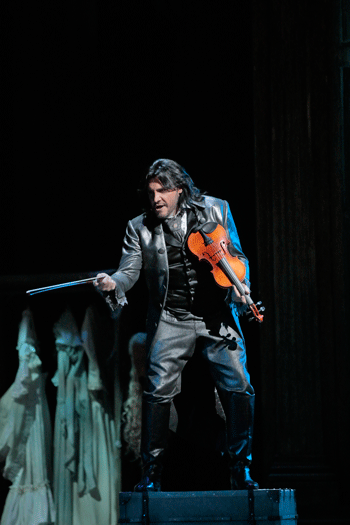 Nicolas Teste as Dr. Miracle
Nicolas Teste as Dr. Miracle
Marta Domingo’s direction gave each character both motivations and expressive activities and she showed that her artistic ability has grown considerably over the last decade. Having sung the title role all over the world, Placido Domingo now leads this opera with a knowledge few conductors can approximate. His tempi were inviting and despite dealing with a singer in the orchestra pit as well as a full cat onstage, the result was a unified whole.
Vittorio Grigòlo sang the title role of Hoffmann with a great deal of panache, creating different aspects of the character in each scene. In the prologue he gives an amusing imitation of the fictional Kleinzach. In Act I he dons rose colored glasses that make him think Olympia is a young girl instead of a roughly assembled automaton as he sings the romance “Ah! vivre deux!” (“Ah! To live together!”) with inviting lyrical tones. With each new love his desire seemed more intense, and it was more difficult for him to deal with rejection, so by the Epilogue, he has lost his grip on reality. Only then did his muse remind him that poetry is empowered by tears, not contentment.
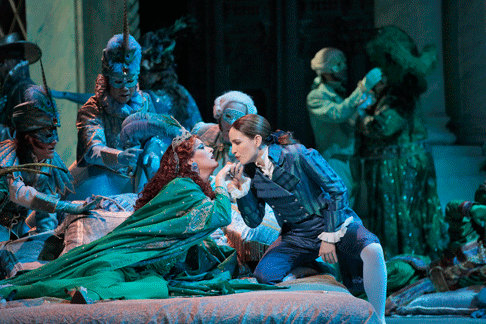 Kate Aldrich as Giulietta and Kate Lindsey as Nicklausse
Kate Aldrich as Giulietta and Kate Lindsey as Nicklausse
Offenbach expected all Hoffmann’s love interests, Olympia, Giulietta, Antonia, and Stella, all to be sung by one soprano. Diana Damrau intended to do that, but for health reasons, she eventually relinquished Olympia, the doll, to So Young Park and Giulietta, the Venetian courtesan, to Kate Aldrich. Park was an incredibly energetic magic doll who sang about "Les oiseaux dans la charmille" (“The Birds in the Arbor”) with sweet, stratospheric notes. Aldrich sang the courtesan with a creamy sound but her acting was anything but subtle. Damrau’s Antonia was both technically exquisite and visually heartrending. Even her dying breath was a perfect trill. Stella does not have much to sing, but her demeanor told us that she would never again embrace Hoffmann. I hope someday Damrau will return to Los Angeles and sing all four heroines. When her health is good, she is most certainly capable of showing Angelinos various facets of characterization with these roles.
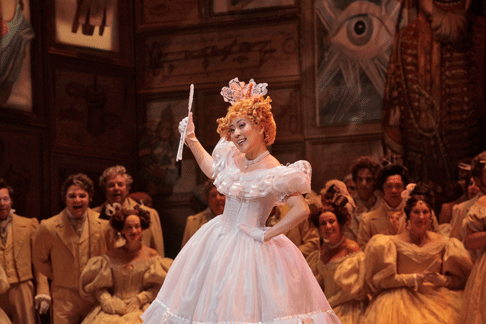 So Young Park as Olympia
So Young Park as Olympia
French bass-baritone Nicholas Testé was to sing all four villains, but became ill the last minute. Thus, an American counterpart, Wayne Tigges, flew in to sing the roles from the orchestra pit while Testé acted them onstage. Most amazing was Tigges’s ability to blend into the ensembles when he could not see the other singers. He is most certainly an incredibly able artist.
Kate Lindsey has sung The Muse/Nicklausse all over the world but last night she outdid herself. Not only was her character the voice of reason, she did an imitation of Olympia that had the audience laughing out loud. Lindsey is a subtle artist but there is deep thought behind her characterizations. French buffo tenor Christophe Mortagne also brought out peals of laughter when Frantz, one of his four servants, attempts serious dance. As tavern owner Luther, Korean baritone Kihun Yoon sang with robust tones that easily filled the hall. Rodell Rosel was a self-important Spalanzani who looked much like one of Offenbach’s contemporaries, Richard Wagner.
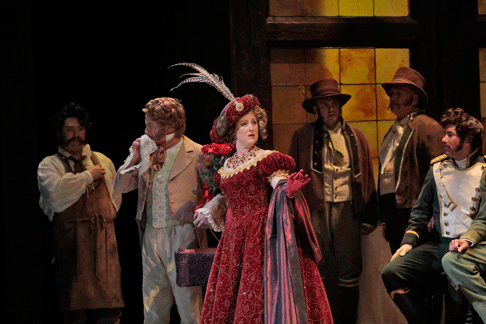 Diana Damrau as Stella (with, at rear left, Kihun Yoon as Luther and Christophe Mortagne as Andres)
Diana Damrau as Stella (with, at rear left, Kihun Yoon as Luther and Christophe Mortagne as Andres)
If there was a slight weak link, it was the chorus, which seemed to be slightly off the beat when they entered. Hopefully that, and the other problems mentioned here will be fixed by the second performance.
Maria Nockin
Cast and production information:
Conductor, Placido Domingo; Director, Marta Domingo; Scenery and Costume Designer, Giovanni Agostinucci; Lighting Designer, Alan Burrett; Chorus Director, Grant Gershon; Choreographer, Kitty McNamee; Fight Director, Ed Douglas; Prompter, Nino Sanikidze; Hoffmann, Vittorio Grigòlo; Nicklause/ Muse of Poetry, Kate Lindsey; Lindorf/Coppelius/Dapertutto/Dr. Miracle, Nicholas Testé/Wayne Tigges; Olympia, So Young Park; Giulietta, Kate Aldrich; Antonia/Stella, Diana Damrau; Andres/Cochinille/ Pitichinaccio/Frantz, Christophe Mortagne; Luther, Kihun Yoon; Hermann, Theo Hoffmann; Nathanael, Brian Michael Moore; Spalanzani, Rodell Rosel; Bass Voice, Reid Bruton; Schlémil, Daniel Armstrong; Crespel, Nicholas Brownlee; Voice of Antonia’s Mother, Sharmay Musacchio.
image=http://www.operatoday.com/hoff_0644.png
image_description=Vittorio Grigolo as Hoffmann and Christophe Mortagne as Frantz [Photo by Ken Howard / LA Opera]
product=yes
product_title=Enchanting Tales at L A Opera
product_by=A review by Maria Nockin
product_id=Above: Vittorio Grigolo as Hoffmann and Christophe Mortagne as Frantz
Photos by Ken Howard / LA Opera
Ermonela Jaho in a stunning Butterfly at Covent Garden
When I saw Jaho at the Barbican in November 2015, in Opera Rara’s semi-staged performance of Leoncavallo’s Zazà I was wowed by the ‘incredible commitment and vocal allure’ that the Albanian soprano displayed as the charismatic chanteuse from the backstreets. Here, similarly, she lived and breathed the role of the culturally and sexually exploited naïf. Her voice may be quite light for a part that demands great stamina and strength, but the power of her stage presence and vocal impact was simply breath-taking. Soft, silky, sensuous, her soprano throbbed with love. The gentleness of her pianissimo captured the tragic naivety of Cio-Cio-San’s misperception of reality. Jaho has a command of phrasing that imbues every melodic line with dramatic meaning. The Act 1 love duet for Cio-Cio-San and Pinkerton soared with a passion so fierce that it seemed almost shocking, coming from one so slight and mild. ‘Un bel dì’ was unbearably sweet, Jaho’s voice a tender wisp, as faint as the puff of smoke she longs to see on the horizon. In Act 1 Butterfly charmed Pinkerton and all; in the second she was resolute through heartbreak; and in the final Act she sank into terrible desolation with dignity.
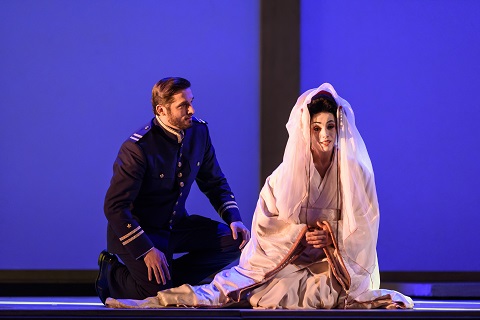 Marcelo Puente (Pinkerton), Ermonela Jaho (Cio-Cio-San). Photo credit: Bill Cooper.
Marcelo Puente (Pinkerton), Ermonela Jaho (Cio-Cio-San). Photo credit: Bill Cooper.
Leiser and Caurier focus less on Cio-Cio-San’s cruel exploitation and abandonment and more on her selfless love; this truly is a fragile Butterfly, not a playful or feisty one, and physically Jaho captures all of her grace and delicacy of her airborne namesake, fluttering and hovering with feathery lightness. The floating sleeves of her silk furisode curve and glide; her long black tresses, or taregami, drape sensuously across her form.
Jaho wholly embodied the delicate sensibility that flinches from danger even as it embraces it. The newly married Butterfly shrinks from Pinkerton: ‘They say that in your country, if a butterfly is caught by man, he’ll pierce its heart with a needle and then leave it to perish!’ But, at the close, her frail wings broken, it is Cio-Cio-San’s own ornamental kaiken that delivers the fatal impalement. When, illumined by pale moonlight, the sakura petals tumbled from the outstretched branches of the lone tree, the tragic pathos was almost overwhelming.
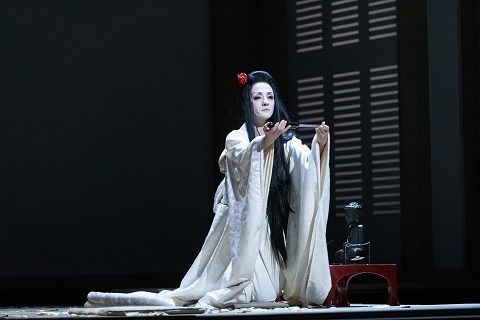 Ermonela Jaho (Cio-Cio-San). Photo credit: Bill Cooper.
Ermonela Jaho (Cio-Cio-San). Photo credit: Bill Cooper.
This was the third time that I have seen this production ( review 2015 ) and I found that my seat in the Amphitheatre offered new visual experiences. The more distant perspective made Christian Fenouillat’s faraway vistas, visible through and beyond the sliding shoji screens, acquire an air of whimsical romance, while the blue-pink mist, or shūyū, which drifts through the ornamental garden infused Butterfly’s entrance with fairy-tale romance. Similarly, the criss-crossing shards of coloured light at the close of Act 1 created an even more penetrating sense of restlessness and disorientation, while, the jarring complementary colours of the lighting scheme seemed to suggest both a dreamy otherworldliness and a disturbing unease.
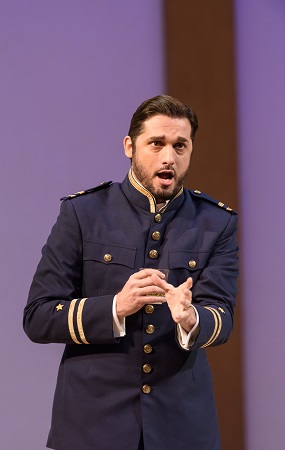 Marcelo Puente (Pinkerton). Photo credit: Bill Cooper.
Marcelo Puente (Pinkerton). Photo credit: Bill Cooper.
Marcelo Puente looked the part as Lieutenant B.F. Pinkerton, though he lacked the leering arrogance more common among interpreters - indeed, the ‘boos for the baddie’ at the curtain call seemed even more inappropriate than usual. Despite some initial graininess in Act 1 and a little strain at the top, by the end-of-act duet Puente had settled into what was a strong performance, if a little stiff dramatically.
Making her ROH debut American mezzo-soprano Elizabeth DeShong exhibited a wonderfully glossy lower register as a fierce, loyal Suzuki, animated of manner and voice; Carlo Bosi’s self-important, guileful Goro suffered the sharp end of her tongue. I’d like to see much more of DeShong at the ROH.
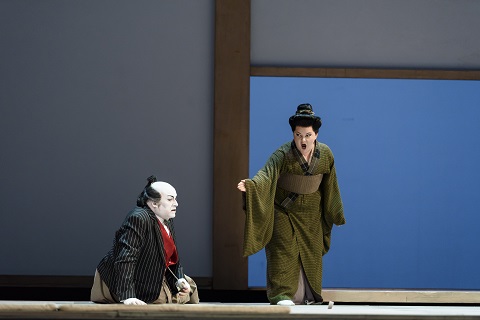 Carlo Bosi (Goro), Elizabeth DeShong (Suzuki). Photo credit: Bill Cooper.
Carlo Bosi (Goro), Elizabeth DeShong (Suzuki). Photo credit: Bill Cooper.
Returning, like Bosi, to reprise their 2015 roles, Jeremy White as the Bonze and Yuriy Yurchuk as Yamadori contributed to the consistent high musical and dramatic standards. White harangued stentoriously; Yurchuk made Yamadori a figure of noble pride. Scott Hendricks was a fairly light-weight Sharpless but interacted well with Jaho. Jette Parker Young Artist Emily Edmonds sang Kate Pinkerton with accomplishment.
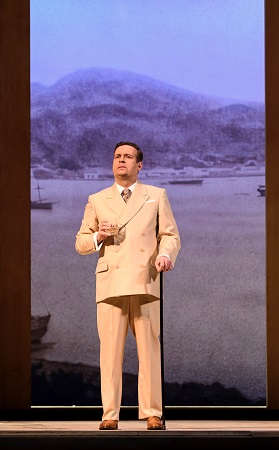 Scott Hendricks (Sharpless). Photo credit: Bill Cooper.
Scott Hendricks (Sharpless). Photo credit: Bill Cooper.
Expertly propelling the drama along with surefooted ease and naturalness, Sir Antonio Pappano made yet another remarkably vigorous contribution in the pit, pushing the surging climaxes to their peaks and allowing the tender moments to speak for themselves.
This is a stunning Butterfly. Grab a ticket if you can, or catch it in cinemas when it is broadcast live on Thursday 30th March: http://www.roh.org.uk/showings/madama-butterfly-live-2017
Claire Seymour
Puccini: Madame Butterfly
Cio-Cio-San - Ermonela Jaho, Lieutenant B.F. Pinkerton - Marcelo Puente, Sharpless - Scott Hendricks, Goro - Carlo Bosi, Suzuki - Elizabeth DeShong, Bonze - Jeremy White, Kate Pinkerton - Emily Edmonds, Imperial Commissioner - Gyula Nagy, Prince Yamadori - Yuriy Yurchuk; Directors - Moshe Leiser and Patrice Caurier, Conductor - Antonio Pappano, Set designer - Christian Fenouillat, Costume designer - Agostino Cavalca, Lighting designer - Christophe Forey, Orchestra and Chorus of the Royal Opera House.
Royal Opera House, Covent Garden, London; Monday 27th March
2017.
image=http://www.operatoday.com/ERMONELA%20JAHO%20AS%20CIO-CIO-SAN%20%28C%29%20ROH.%20PHOTO%20BILL%20COOPER.jpg
image_description=Madame Butterfly, Royal Opera House, London
product=yes
product_title=Madame Butterfly, Royal Opera House, London
product_by=A review by Claire Seymour
product_id=Above: Ermonela Jaho (Cio-Cio-San)
Photo credit: Bill Cooper
March 27, 2017
Brave but flawed world premiere: Fortress Europe in Amsterdam
The number of migrants trying to reach Europe by sea is already picking up, as it does every year. Putting their lives in the hands of unscrupulous smugglers, scores of them will drown. The ones who reach European shores will face years of uncertainty in asylum centers and hostility from nativists and nationalists who feel threatened by them. Librettist Jonathan West, informed by the writings of Ilja Leonard Pfeijffer, bravely tackles the most salient aspects of the European migrant crisis. The libretto is economical and purposeful in the beginning, but loses momentum halfway through. Tsoupaki’s atmospheric score contains some involving scenes, but is ultimately too circuitous to be fully convincing.
Totally up to the mark, on the other hand, are the cast and production. Director Floris Visser keeps things clear and to the point. Costumes and set are unfussy. On a rotating stage, sharp rocks denote a Greek island and a large door is the gateway to Europe. The drowning chorus wears life jackets sent over from Lesbos by an NGO that works with migrants. Soprano Rosemary Joshua sang Europa, an old woman living in Brussels. She is the mouthpiece of the current anti-immigrant sentiment shaping the European political landscape. With meticulous singing and crisp enunciation, Joshua created a focused portrait of a woman clinging to the past and terrified of the present. Her hankering for Old Europe is poetically expressed through the myth of Europa, the Phoenician princess who dreamed of two continents, Asia and an unnamed continent, fighting over her. The next morning she was carried away across the sea to Crete by Zeus disguised as a beautiful white bull. Europa gave Zeus sons and her name to her new home.
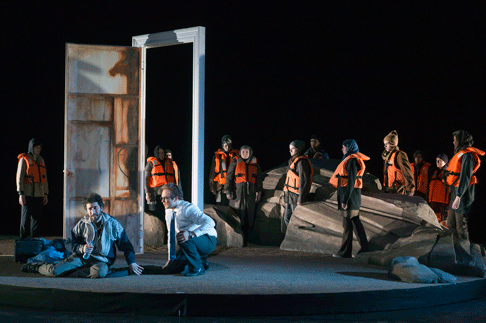 A scene from Fortress Europe
A scene from Fortress Europe
Political tensions over the influx of migrants are explored in conversations between Europa and her son Frans, a politician. Tenor Erik Slik sank his teeth wholeheartedly into this role in an emotionally charged and vocally assertive performance. Frans, a progressively sympathetic figure, is torn between his political mandate to guard European borders and his empathy for the refugees. While Europa recalls her youthful romance with phrases curling into melismas, Frans reminds her that even she once washed up in Europe from foreign shores. Mother and son fight over granting asylum to Amar, a Syrian who is the sole survivor of a catastrophic crossing. Europa refuses him entry, destroying him. Bass-baritone Yavuz Arman İşleker sang Amar with much vocal beauty and dignity. His slight Turkish accent added to the complexity of the topic under scrutiny. Amar’s re-enactment of the drowning with the chorus of migrants was the emotional peak of the opera. The excellent Netherlands Student Chamber Choir supplied young, vibrato-light voices for the spectral chorus. Singing a haunting Arab folk song, they fell silent one by one, shedding their life jackets onto a forlorn heap.
Conductor Bas Wiegers led the seven-strong Asko|Schönberg ensemble with confidence. The oboe and cor anglais had the lion’s share of the solos, in languid Eastern scales and plaintive keening. Tsoupaki is free with musical idioms, braiding passages for string quartet with Greek Orthodox hymns and Arab melodies. A harp evokes nostalgia and percussion crescendos mark dramatic events, while sound effects recreate wind and waves. Lucid orchestral colors suggest an exposed beach or the glade where Europa gives herself to Zeus. The problem is that Tsoupaki’s vocal writing is rhythmically repetitive and her melodies tenuous. Ariosos for the soloists begin promisingly, but end up where they started without evolving. The percussion flare-ups lose their impact through overuse. She passes over the opportunity to write a lively ensemble scene when journalists cross-examine Frans about his immigration policy. The entire press conference is spoken, and very well too, but it is too long.
Wordiness, successfully avoided during the trenchant phone conversations between mother and son, mars their final confrontation. They become megaphones for pro- and anti-immigration arguments and the music is not inventive enough to sustain interest. Amar’s tragic end is a horrific climax, but it arrives to late. Fortress Europe is the first installment of a trilogy about sociopolitical bushfires called Sign of the Times, produced by a company called Opera Trionfo. Dutch National Opera is collaborating on the project and this world premiere was part of their annual Opera Forward Festival. Musically, this ninety-minute work never reaches the boiling point required by its subject matter, but its best moments and the high quality of the performance makes one curious about its sequels.
Jenny Camilleri
Cast and production information:
Europa: Rosemary Joshua, soprano; Frans, the politician: Erik Slik, tenor; Amar, the refugee: Yavuz Arman İşleker, bass-baritone. Director: Floris Visser; Set and Costume Design: Dieuweke van Reij; Lighting Design: Alex Brok. Composer: Calliope Tsoupaki; Libretto: Jonathan West; Conductor: Bas Wiegers. Netherlands Student Chamber Choir, Asko|Schönberg. Seen at the Rabozaal, Stadsschouwburg, Amsterdam, Wednesday, 22nd March 2017.
image=http://www.operatoday.com/17.03.19-1117.png image_description=A scene from Fortress Europe [Photo by Hans van den Bogaard] product=yes product_title=Brave but flawed world premiere: Fortress Europe in Amsterdam product_by=A review by Jenny Camilleri product_id=Above: A scene from Fortress EuropePhotos by Hans van den Bogaard
New Sussex Opera: A Village Romeo and Juliet
The company makes a fair job of the task too. There is much to admire and enjoy in this production, but ultimately an overly complicated design scheme impedes rather than assists dramatic momentum. Moreover, at the E.M. Forster at Tonbridge School the cast struggled both to create credible characters and relationships, and to communicate the text with sufficiently clarity.
To be fair, the singers may not be entirely to blame. Delius concentrates on the opera’s central lovers - Sali and Vrenchen - and the other characters are only lightly sketched. There is little to differentiate them musically and, in any case, the characters’ vocal lines are shaped by harmonic imperatives rather than given individual melodic identity. Furthermore, the lovers themselves are more ‘emblems’ - of, paradoxically, both childhood innocence and, in the opera’s final moments, consuming passion - than ‘real’ figures. The composer seems to have been more concerned with what might be termed the ‘emotional landscape’, as evoked by the instrumental preludes that precede each of the six scenes.
Moreover, the E.M. Forster Theatre itself did not prove the most sympathetic venue for opera. The auditorium is fairly small, and there is no pit, which meant that the audience were seated very close to the orchestra - the excellent 24-piece Kantanti Ensemble - which served to distance the action. It did not help that conductor Lee Reynolds, who displayed enormous sensitivity to Delius’s musical rhetoric and no small skill in guiding and encouraging his instrumentalists, is himself rather tall. It was hard to avoid the visual distraction in the centre of one’s vision and focus on the stage action, particularly as the stage drapes at the rear of the stage further hindered the projection of the vocal lines.
The playing of Kantanti Ensemble was one of the strengths of the performance. Although Reynolds occasionally allowed his players a bit too much free rein, it was a treat to hear the textural and melodic delicacies. Tom Pollock’s horn playing was superb (he can be forgiven for tiring a little towards the close), and he was matched by Sacha Rattle doubling on clarinet and bass clarinet; the double basses’ tone was deliciously dark and there was some explosive drama from timpanist Will Renwick. If the sixteen string players inevitably could not generate a luxuriant stream of sound, then the accuracy of their playing was impressive, and leader Beatrice Philips offered sure, sweet-toned solos.
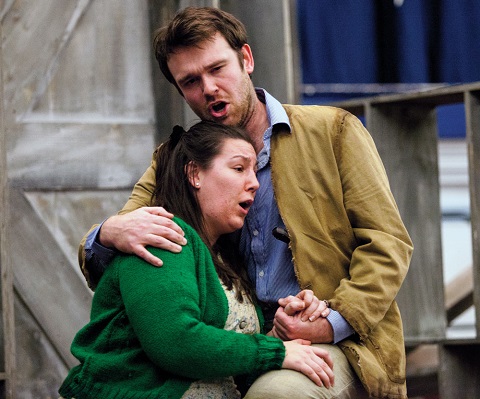 Kirsty Taylor-Stokes and Luke Sinclair. Photo credit: Robert Knights.
Kirsty Taylor-Stokes and Luke Sinclair. Photo credit: Robert Knights.
Director Susannah Waters and her design team told Delius’ tale clearly. The composer’s libretto, drawn from a short story by Gottfried Keller, reprises Shakespeare’s themes of family feuds and doomed love. Two farmers, Marti and Manz, contest the narrow strip of wild land that separates their fields and which is owned by the Dark Fiddler who, as an illegitimate son, cannot inherit. Though prohibited by their fathers, during the bitter dispute that bankrupts both farms, Sali and Vrenchen meet secretly. Friendship blossoms into love, while their fathers surreptitiously encroach onto the fallow land, inch by inch. The Dark Fiddler reappears and cautions that they should beware the time when the land is no longer a haunt of birds and animals, a warning which presages the tragedy that unfolds.
Anna Driftmier’s set is evocative. At the rear, distressed windmills flap and whirl, beside denuded tree trunks; in this barren world, one can imagine why the two farmers stake their claim for the wild pasture. However, Driftmier’s design - while ingenious - is over-complicated: the persistent choreographed re-arrangement of wooden planks and slats - they form pathways, platforms and are assembled into raised frames to suggest homes and bridges - must have caused the community chorus, effectively reduced to stage-hands, no end of trouble in rehearsal. It’s just as well that the chorus don’t have an awful lot of musical business but they sang warmly and with confidence in the marriage scene, though the communal festivities were a bit stiff.
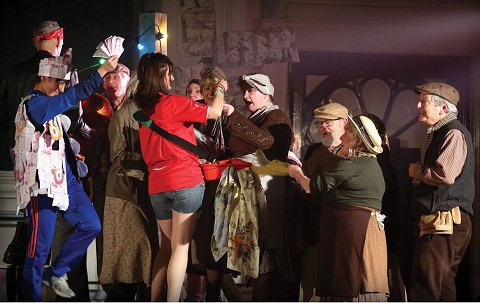 New Sussex Opera Chorus (The Fair). Photo credit: Robert Knights.
New Sussex Opera Chorus (The Fair). Photo credit: Robert Knights.
While the chorus effected the set transitions slickly, their complicated reshuffles could not help but be a distraction during the instrumental episodes. In the fairground setting of Scene 5 the necessary manoeuvring undermined the tense jollity of the scene, though the garish costumes were a welcome splash of colour emphasising the fickle unpredictability of this uncanny world. Even the famous ‘Walk to Paradise Garden’ was not spared: we witnessed a dumb show as Sali forged a stepping-stone conduit, stopping on their arduous journey to remove one boot and bathe his foot in a stream. And, in truth, despite the strong greens, purples, reds of Jai Morjaria’s lighting design, which created an eerie otherness, the plywood boxes and boards never looked like anything other than very real Ikea bookcases.
Tenor Luke Sinclair was buoyant and managed the high tessitura well, conveying Sali’s irrepressible impetuousness, while Kirsty Taylor-Stokes’ richly coloured mezzo and full vibrato suggested the ardour blossoming in the innocent Vrenchen’s heart, and captured her despair at the start of Scene 4. Ian Beadle’s baritone needed more nuance and portentous resonance to capture the Dark Fiddler’s enigmatic air; Beadle was all too amiable, but his song in praise of the ‘Vagabond wind’ was appealingly sung.
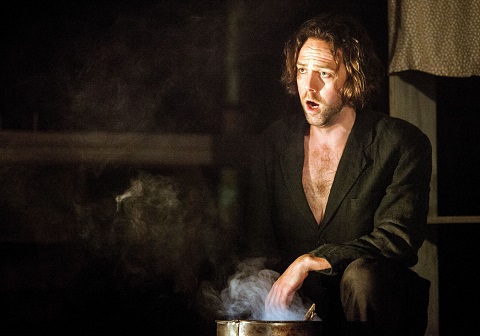 Ian Beadle. Photo credit: Robert Knights.
Ian Beadle. Photo credit: Robert Knights.
Geoffrey Moses (Marti) and Robert Gildon (Manz) established the context and their characters deftly at the start, though Moses’ diction was weak at times and I found Gildon’s bass a little tense and occasionally unfocused. As the Young Sali and Young Vrenchen, Alex Edwards and Nell Parry were sadly over-powered (a case for a mic?); Edwards was almost inaudible, while Parry had to strain to rise above the instrumental texture.
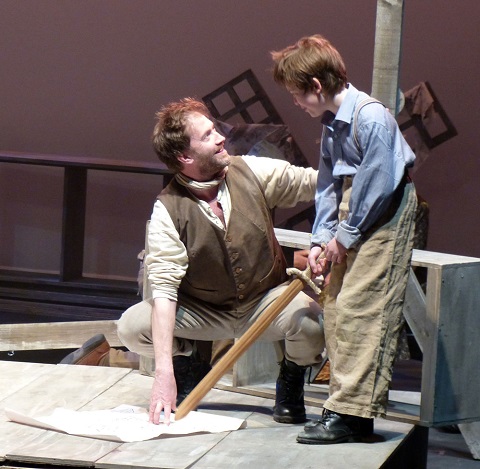 Robert Gildon and Alex Edwards. Photo credit: David James.
Robert Gildon and Alex Edwards. Photo credit: David James.
The final moments of the opera were absorbing and well-crafted. When the lovers are recognised at the fair, Sali suggests that they should go to the Paradise Garden where they find the Dark Fiddler and his entourage drinking and carousing. Rather than submit to the temptations of his hedonistic life, they choose to drift down river in a gradually submerging boat, resigned to the Tristan-esque double suicide that must follow. I think that the ‘wrist-slashing’ would have been best left to the imagination, but the final tableau was artfully lit in a gleam of ultramarine, and superbly paced by Reynolds.
This was an admirably ambitious production, but given the demands of performing such a musically and dramatically challenging work in five different venues one couldn’t help feel that a more minimalist staging might have more effectively focused attention on the internal drama - the power passions and dreams that are embodied in Delius’ score - which develops in the village lovers’ hearts and minds.
There are three further performances: on Tuesday 28th March at Cadogan Hall, London; and on Friday 31st March at the Stag Theatre, Sevenoaks, and on Sunday 2nd April at the Devonshire Park Theatre, Eastbourne.
Claire Seymour
Delius: A Village Romeo and Juliet
Sali - Luke Sinclair, Vrenchen - Kirsty Taylor-Stokes, The Dark Fiddler - Ian Beadle, Manz - Rob Gildon, Marti - Geoffrey Moses; Young Sali - Alex Edwards; Young Vrenchen - Nell Pary; Wild Girl - Georgia Cudby; Director - Susannah Waters Conductor - Lee Reynolds, Designer - Anna Driftmier, Lighting designer - Jai Morjaria, New Sussex Opera Chorus, Kantanti Ensemble.
E.M. Forster Theatre, Tonbridge School; Sunday 26th March 2017.
image=http://www.operatoday.com/Sali-and-Vrenchen-3-RK.jpg image_description=New Sussex Opera, A Village Romeo and Juliet product=yes product_title=New Sussex Opera, A Village Romeo and Juliet product_by=A review by Claire Seymour product_id=Above: Kirsty Taylor-Stokes and Luke SinclairPhoto credit: Robert Knights
March 26, 2017
Cast announced for Bampton Classical Opera's 2017 production of Salieri's The School of Jealousy
Setting a sharply cynical libretto by Caterino Mazzolà, this opera buffa was written in Venice and first performed at the Teatro San Moisè in 1778. It was selected to inaugurate the Emperor Joseph II’s new Italian opera troupe at the Burgtheater in Vienna in 1783, with an outstanding cast including the star English soprano Nancy Storace (later one of Mozart’s favourite sopranos and the first Susanna) as the Countess, and Francesco Benucci (later Figaro and Guglielmo) as Blasio. Salieri revised the score for these performances including new arias specially for Nancy Storace, and the librettist Lorenzo da Ponte added some textual adjustments. The opera made a huge impact and became one of the highlights of Storace’s career.
La scuola de’ gelosi was performed widely across Europe - from London to St Petersburg - for several decades, and was praised warmly by Goethe. The opera’s great success in Vienna almost certainly inspired Da Ponte and Mozart to create La scuola degli amanti which eventually became known by its alternative title Così fan tutte and there are many narrative parallels between the two. In both fidelity and honesty are tested by means of dangerous games and deceits, and the manipulative Lieutenant in Gelosi is a counterpart to Don Alfonso.
It was the first of Salieri’s works to be performed in London, in 1786: The Herald judged “it is the first lyric drama that may be termed strictly good, whether we advert to the poem itself, the music, or the performance” and the Morning Post called it a “masterly composition” that “does great honour to Salieri, whose reputation as a composer must rise infinitely in the musical world, from this very pleasing specimen of his abilities”. For performances in 1780 at the court theatre at Esterháza, Haydn composed two insertion arias.
La scuola de’ gelosi is enjoying a current revival across Europe, including performances this year in Florence and Vienna and a recording by L’arte del mondo on Deutsche Harmonia Mundi. Bampton has also selected the work to mark the bicentenary of the death of Nancy Storace in 1817.
Plot outline
The Count Bandiera is a skilful philanderer, but takes a big risk when he invites Ernestina, wife of a pathologically jealous businessman, out on a shopping trip. A decidedly non-PC visit to a madhouse, fortune-telling gypsies and the lessons taught by paintings are just some of the bizarre situations encountered in this scintillating comedy of marital dis-harmony.
Cast
Countess Rhiannon Llewellyn (soprano)
Ernestina Nathalie Chalkley (soprano)
Carlotta Kate Howden (mezzo-soprano)
Count Alessandro Fisher (tenor)
Tenente Thomas Herford (tenor)
Blasio Matthew Sprange (baritone)
Lumaca Samuel Pantcheff (baritone)
Bampton Classical Opera was founded in 1993 by its artistic directors, Gilly French and Jeremy Gray, and stages less familiar works from the late Classical period, many of which might not otherwise be heard. The performances are of the highest musical quality, yet are relaxed and welcoming with fresh and accessible English translations, and can be enjoyed even by those with little opera experience. The company also provides valuable performance opportunities for the country’s finest young professional singers, and hosts a Young Singers’ Competition every two years.
Bampton Classical Opera stages productions in rural venues in Oxfordshire and Gloucestershire as well as regularly in London at St John’s Smith Square. Other significant venues and festivals have included Wigmore Hall and Purcell Room, Buxton Festival, Cheltenham Festival and Theatre Royal Bath. Amongst their many performances have been UK premières of Bertoni Orfeo, Marcos Portugal The Marriage of Figaro, Paer Leonora, BendaRomeo and Juliet, Gluck Il Parnaso confuso,Philemon and Baucis, Salieri Falstaff and La grotta di Trofonio.
The delightful Deanery Garden at Bampton provides a charming and picturesque venue for open-air opera, with an excellent natural acoustic. Westonbirt School is a spectacular Victorian mansion, with extensive Grade I listed gardens: the performances take place in the Orangery Theatre. Audiences are encouraged to bring their own garden chairs and enjoy a pre-performance or interval picnic.
St John’s Smith Square is the most historic of London’s concert halls and provides an outstanding and appropriately eighteenth-century setting for this performance.
The School of Jealousy performances, with free pre-performance talks:
The Deanery Garden, Bampton, Oxfordshire OX18 2LL
7.00 pm Friday 21 and Saturday 22 July
The Orangery Theatre, Westonbirt School, near Tetbury, Gloucestershire GL8
8QG
5.00 pm Monday 28 August
St John’s Smith Square, London SW1P 3HA
7.00 pm Tuesday 12 September
La voix humaine: Opera Holland Park at the Royal Albert Hall
For this performance of Poulenc’s one-woman emotional roller-coaster, La voix humaine (1959), Opera Holland Park ventured indoors, into the genteel setting of the Elgar Room at the Royal Albert Hall. The room is not a large one and some of the sell-out crowd may have found their sightlines somewhat restricted as Marie Lambert’s intense, taut direction placed French soprano Anne Sophie Duprels at the centre of a slightly raised platform, often kneeling, crouching or reclining.
But, the intimacy of the setting, together with Duprels’ astonishing presence and impact, more than made up for any visual impediment. Duprels’ tour de force also helped mitigate the drabness of the design. Given the nature of this one-off excursion to the RAH, allowance can be made for adopting a limited staging, especially for a work that in fact needs no staging at all (except perhaps a single property, the telephone itself, which is almost a second character) to make its emotional and dramatic impact).
But, Lambert’s fluctuating lighting was distracting. And, the dilapidated plywood bedstead, daubed with blue paint splashes, did little to evoke Parisian chic. Nor did it suggest the bedroom ‘asleep with remembering’ which contains just a woman and the telephone that she clutches, ‘like a revolver’, as Cocteau demanded when instructing Poulenc about the design and staging of the opera in 1959. However, the blue cord of the telephone was a subtle but powerful visual image: Duprels’ ultramarine fingernails suggested it was delivering an intravenous infusion of a blue barbiturate, sedating and hypnotising the anxiety-fuelled woman, as she slipped ever nearer to sleep, or suicide.
Fortunately, Duprels’ performance pushed any concerns aside. As ‘Elle’, the lonely woman who makes a desperate telephone call to the lover who has abandoned her, she spanned an enormous emotional spectrum from terror to tremulous hope, from existential despair to excitement. We hear just one side of the conversation but, through careful pacing of the silences and nuanced repetitions of others’ words, Duprels was able to evoke a world beyond the forlorn bedroom, thereby deepening her own alienation from normal human interaction and exchange. As her attempted tête-à-tête was continually disrupted by wrong-numbers, disconnections, crossed-wires and an intrusive operator, Elle’s inner distress became a palpable but unspoken inner cry for help, ‘Can you hear me?’
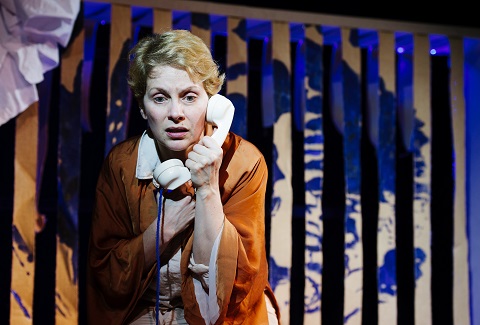 Anne Sophie Duprels. Photo credit: Alex Brenner.
Anne Sophie Duprels. Photo credit: Alex Brenner.
Cocteau’s 1930 play grew out extreme personal crisis: addicted to opium, he was in the midst of a turbulent affair with a young writer, Jean Desbordes, who eventually abandoned Cocteau for a woman and joined the French Resistance movement, suffering a torturous death at the hands of the Gestapo. Poulenc, in the 1950s, was also suffering private distress, depression and drug addiction following the death of his partner Lucien Roubert. Though the work, in both dramatic and operatic form, conveys the universal experience of grief for a lost love, there is a crypto-homosexual insinuation in Elle’s quasi-masochistic sensibility which recalls the plays of Tennessee Williams.
Cocteau does not seem particularly sympathetic towards his protagonist. Her lies are barefaced - she is wearing his favourite dress (in Lambert’s production she is draped in an unflattering, dirty, crumpled beige night-shirt); she has spent the day with her best friend, Marthe, when in fact she hasn’t left the room; she’s coping well, even though she later confesses she has tried to take her own life just the evening before.
But, as Elle recollected old love letters and rambled incoherently - almost a caricature of emotional neediness - Duprels managed to draw sympathy for the suffering women, despite her histrionics and melodrama. The moment when Elle discovers that her lover’s mendacity equals her own was full of pathos. We infer that he is calling her from his apartment, and when the line suddenly goes dead, she re-dials, only to be answered by the servant Joseph. Duprels’ reiteration of Joseph’s words, ‘Monsieur is not in and will not be returning home tonight’, was laden with tragic realisation and recognition.
Duprels confirmed that she is a tremendous singing actress. Not surprisingly, every word of the French text was audible and she had a sure sense of how to accommodate her voice to the small venue. She conjured an enormous variety of vocal colour and tone: at times whispering, speaking, crooning, then flowering in full blown lyrical ecstasy, gleaming at the top, breathless and dusky below. As she tried vainly to win her lover back with nostalgic remembrance, her voice was caressing, but when pain and pride broke through Duprels exposed Elle’s bitterness, introducing a shrill stridency or hardness of tone. Her physical commitment to the role was consummate, the final moments of Elle’s breakdown gripping and troubling.
Pascal Rogé was an attentive, detailed and discreet accompanist, powerfully interjecting with angular, jabbing motifs to portray the climactic peaks of Elle’s nervous disintegration, but elsewhere delicately hinting at wistful memories of tenderness or expanding lyrically to convey past passions.
Duprels demonstrated just how powerful a musico-dramatic experience she could create with limited means and time. I greatly admired Duprels’ performance last year in Mascagni’s in Iris and her performance here certainly whets the appetite for this year’s season at Holland Park, where in July she will be reunited with Lambert in a new production of Leoncavallo’s Zazà whose eponymous ‘heroine’ - a chanteuse raised from the backstreets to the bright lights - runs her own gamut from fervent passion to dejected self-pity.
Claire Seymour
Poulenc: La voix humaine
Anne Sophie Duprels (soprano), Pascal Rogé (piano)
Opera Holland Park, Elgar Room, Royal Albert Hall, London; Wednesday 22nd March 2017.
image=http://www.operatoday.com/Anne%20Sophie%20Duprels%202%20%28c%29%20Alex%20Brenner.jpg image_description=Opera Holland Park, La voix humaine product=yes product_title=Opera Holland Park, La voix humaine product_by=A review by Claire Seymour product_id=Above: Anne Sophie DuprelsPhoto credit: Alex Brenner
March 21, 2017
London Handel Festival: Handel's Faramondo at the RCM
The pseudo-historical plot is an almost unfathomable cat’s-cradle of intrigues, misalliances and mistaken identities. The King of the Franks, Faramondo has killed Sveno, the son of Gustavo, the Cimbrian King. The latter swears vengeance but when his knife is poised above Clotilde, Faramondo’s sister, Gustavo promptly falls in love with his prisoner, who is herself in an amorous dalliance with Alfonso, Gustavo’s other son. Meanwhile, Gustavo’s daughter, Rosimonda, whom he dangles as a prize to would-be avengers, has fallen in mutual love with Faramondo, but struggles with her split allegiances - and against Faramondo’s rival for her heart, Gernando.
The result: amorous stalemate. Lovely aria follows lovely aria as the protagonists, often alone on stage, bewail the deadlock. As degeneracy ensues, it’s not always clear where enmity and loyalty dwell. It’s really no surprise when - in Trovatore fashion - Sveno turns out not to have been Sveno after all, but Childerico, the son of Gustavo’s ambitious general Teobaldo who swapped the babes at birth.
Despite the torturous and dramatically encumbering narrative knots, the score is full of fine features: incisive sinfonie (one for each act); beautiful melodies; lively, springy rhythms; interesting - often quite sparse - instrumental colouring; and arias that contrast emotional excitement with lyrical breadth. Handel reduced the recitative in Gasparini’s version of the opera - which had already considerably sliced Zeno’s original libretto - to the barest of minimums but, given that there is no real ‘action’, this is not a hindrance to a dramatic comprehensibility that is already stretched to the limits.
When Göttingen Händel-Festspiele director Laurence Cummings conducted the opera at the June 2014 Festival he and his director, Paul Curran, opted wisely to dispense with historical ‘veracity’ and shifted the action to a mafioso gangland in the mid-twentieth century. For this collaboration between the London Handel Festival and the Royal College of Music’s International Opera School director William Relton and designer Cordelia Chisholm retain the Scorsese-inspired setting and add a dash of West Side Story in the form of rival gangs of knife-wielding ganstas and hoods.
Faramondo is the leather-clad leader of one band of thugs, Gernando heads a rival clan of glue-sniffing skinheads, while Gustavo is a sharp-suited casino magnate. We’re in a twilight zone. Blood oaths bind the members of Gustavo’s Family and flick knives flash in the stark glare of the strip lights on every seedy corner. Casting a patina of glamour over this sordid underworld are the sultry lights and glitter balls of Gustavo’s wine bar. At one point, Rosimonda - glitzy in gold lamé - spins a star turn in front of the mic to entertain the gamblers.
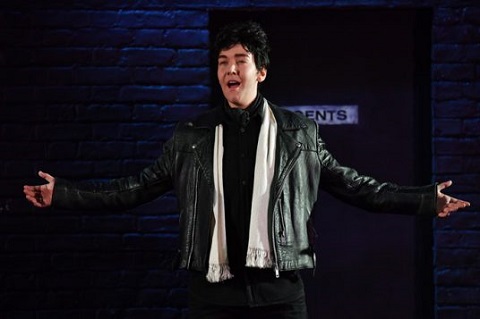 Ida Ränzlöv. Photo credit: Chris Christodoulou.
Ida Ränzlöv. Photo credit: Chris Christodoulou.
There’s plenty of ‘business’, much of it clever, some of it overly fussy, nearly all of it irrelevant to what is being sung, or even felt. The da capo repeats are supplemented not with melodic ornamentation but with excessive alcohol and drug consumption. Faramondo’s mobsters swig from bottles of beer, he gulps from a hip-flask, and having emptied the used glasses on the tables of Gustavo’s, Clotilde grabs a bottle and lets the bubbles flow. Rosimonda drags agitatedly on a cigarette, while Gernando fuels his da capo with a deep inhalation of solvents. Nifty use of a cross curtain, which allows for swift changes of locale, keeps things swinging along.
After a vibrant overture from the London Handel Orchestra led by Oliver Webber, the cast took a little while to settle. There were some slips of intonation and stage-pit timing in the opening few numbers, the coloratura was sometimes rather muddy and I don’t think I heard a trill characterised by the requisite evenness, accuracy of tuning and speed in the first Act. That’s not to suggest that the singing was bad - there was much colour and charm - just that a certain polish was lacking.
Fortunately, the singers found their feet subsequently. In the title role, however, mezzo soprano Ida Ränzlöv was in a class of her own from the start. There is a real richness to Ränzlöv’s sound and a vividness of tone; she demonstrated a natural feeling for the Handelian phrase, delivering the coloratura with effortless seamlessness and crafting a fine cantabile. Ränzlöv also demonstrated dramatic range and - in this opera, no mean feat - credibility, conveying both Faramondo’s vicious streak and an underlying tenderness.
Similarly, Beth Moxon convincing captured the conflicted Rosimonda’s inner battle with desire and duty. The only thing she seemed certain about, as she strutted and fretted back and forth, compulsively chain-smoking, was her disdain for Gernando. Rosimonda’s vengeance aria bristled, but her final aria charmed and calmed.
<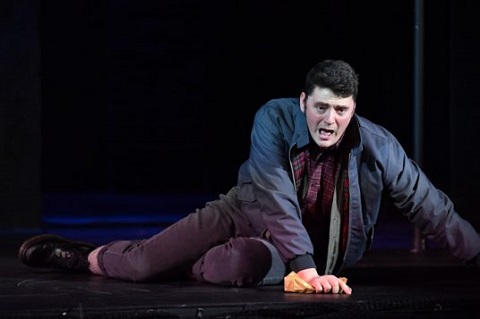 Timothy Morgan. Photo credit: Chris Christodoulou.
Timothy Morgan. Photo credit: Chris Christodoulou.
The few ensembles of Acts 2 and 3 contain some of the finest music of the opera; the cheerful intertwining of the central lovers mezzos at the end of Act 2 offered hope for resolution, although Clotilde and Adolfo shared a more muted moment at the start of the final Act.
Soprano Harriet Eyley sparkled as a gamine Clotilde. Josephine Goddard was her hopelessly love-struck suitor; though Goddard’s soprano has vocal elegance, her Jimmy Krankie wig did not add to her dignity.
New Zealand baritone Kieran Ryaner was a dark-voiced Gustavo but though he could call on significant weight and power his coloratura was not always finely focused; countertenor Timothy Morgan relished Gernando’s unsavoury sleaziness. Baritone Harry Thatcher was a confident Teobaldo and Lauren Morris made her mark as the diffident nerd Childerico, even though the role has no arias.
With revenge, restitution and realignment all satisfactorily effected, Faramondo’s final aria led into a spirited chorus. But, while the protagonists sang of Virtue’s merits, the villainy continued, as Faramondo’s heavies despatched the victims of Gustavo’s lingering resentment and rancour: a quick flick of an efficient knife and off they went, dragged feet first. In Relton’s eyes, there is no distinction between those with morals and those without. I guess they are all Goodfellas.
Claire Seymour
Handel: Faramondo
Faramondo - Ida Ränzlöv, Clotilde - Harriet Eyley, Gustavo - Kieran Rayner, Rosimonda - Beth Moxon, Adolfo - Josephine Goddard, Gernando - Timothy Morgan, Teobaldo - Harry Thatcher, Childerico - Lauren Morris; Director - William Relton, Conductor - Laurence Cummings, Designer - Cordelia Chisholm, Lighting designer - Kevin Treacy, London Handel Orchestra.
Britten Theatre, Royal College of Music, London; Monday 20th March 2017.
image=http://www.operatoday.com/Kieran-Rayner-Gustavo-Harriet-Eyley-ClotildeFaramondo-London-Handel-Festival-Credit-Chris-Christodoulou-536x357.jpg image_description=London Handel Festival, Faramondo product=yes product_title=London Handel Festival, Faramondo product_by=A review by Claire Seymour product_id=Above: Kieran Rayner and Harriet EylesPhoto credit: Chris Christodoulou
Brahms A German Requiem, Fabio Luisi, Barbican London
The Barbican Centre is built over the remains of a much older London, which still exists in hidden corners. During the week, the metropolis is manic, but on a Sunday night, a quiet calm descends, and once more you can feel the presence of the past amid the high tech towers and traffic. Under the Barbican Hall itself was Three Herring Court, where my companion's ancestors lived in extreme poverty. An atmospheric way in which to experience Brahms German Requiem, which commemorates the endurance of the human spirit across boundaries of time and place. Not for nothing did Brahms blend together verses from the Old and New Testaments, evidence of an upbringing steeped in North German Lutheran tradition, even though he rejected conventional piety, and lived much of his life in staunchly Catholic Vienna. .
The voices of the London Symphony Chorus rose beautifully from the hushed opening chords. "Selig sind, die da Lied tragen", for those who go forth weeping bearing precious seed will return "Mit Freuden und bringen ihre Garben". Death is a not an end, but a process. With Sir Simon Rattle as Music Director of the LSO, Londoners get another advantage : Simon Halsey, Rattle's choral counterpart through the years at Birmingham and in Berlin. The LSO Chorus sounded luminous, voices carefully blended. If anything, the LSO Chorus sounded even richer in the second movement Denn alles Fleisch es ist wie Gras though this brought the orchestra to the fore. The "march" theme was particularly well defined, with a good sense of surge underlying the solemn, deliberate pace, so when the lyrical motif appeared, it suggested light and hope. The fanfare at the end of the movement was understated but confident.
Simon Keenlyside sang the baritone part, which he has taken many times before. Experience showed. Brahms quotes Psalm 9 (verses 4 to 7), where a man contemplates his fate : humility is of the essence, surrounded as he is by the tumult in the orchestra. Yet the assured, unforced timbre of Keenlyside's singing highlighted the inner strength that comes from faith, whatever the source of that faith. When the chorus joined in, the protagonist was no longer alone, in every sense. Perhaps for this reason the song with soprano (Julia Kleiter) Ihr habt nun Traurigkeit was added, for it is a moment of illumination, before the mood turns sombre yet again. The solemn processional of the second movement echoes in the sixth. Forceful chords from the orchestra, and a blazing fanfare of brass, strings and percussion, and the chorus in full swell , for momentous changes are to come. The trumpets rang out, as in the Book of Revelation, a trumpet will herald the End of Time, when the dead of past ages will be raised to life again. Keenlyside's voice rang out "Wir werden verwandelt werden" and the chorus entered, forcefully "Hölle, wo ist dein Sieg!" A thunderous finale, after which it took some moments to recover.
Fabio Luisi and the London Symphony Orchestra were impressive, and their Schubert Symphony no 8 was excellent, well poised and stylish. But the full honours went to the London Symphony Chorus, for Brahms's German Requiem is one of the high points in the choral repertoire. "Selig sind die Toten.....daß sie ruhen von ihrer Arbeit". Rich, fulsome playing from the LSO, luminous singing from the LSO Chorus. The German Requiem concluded in transcendance.
Anne Ozorio
image=https://upload.wikimedia.org/wikipedia/commons/thumb/a/a2/Johannes_Brahms_portrait.jpg/256px-Johannes_Brahms_portrait.jpg
product=yes
product_title= Schubert:Symphony no 8 "The Unfinished", Brahms A German Requiem, Fabio Luisi, London Symphony Orchestra, London Symphony Chorus, Simon Keenlyside, Julia Kleiter, Barbican Hall London, 19th March 2017
product_by=A review by Anne Ozorio
product_id=Johannes Brahms
March 19, 2017
Káťa Kabanová in its Seattle début
The immediately preceding production of Seattle Opera’s 2016-17 season had been the much-traveled Traviata from the atelier of Peter Konwitschny, and the show’s rather coarse updating and arbitrary dramaturgy had not gone down at all well with the company’s conservative but sophisticated audience. Was this to be another evening of mannered, second-hand Regietheater? The immense bare black box confronting the house as we entered was not promising: even the supertitle screen looked more like a stage-wide guillotine than a refuge for the eyes of the Czech-impaired among us.
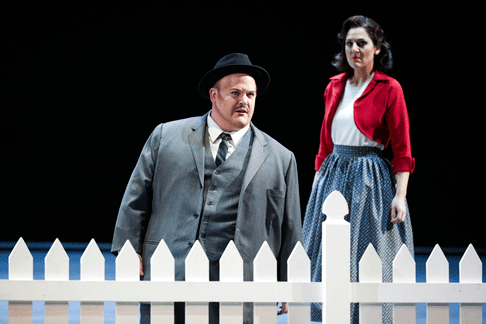 Nicky Spence (Tichon) and Maya Lahyani (Varvara)
Nicky Spence (Tichon) and Maya Lahyani (Varvara)
Well, Regietheater it was, but of the engaged, engaging audience-friendly kind. As the music began, the marvelous American dramatic soprano Melody Moore stood center-stage, impaled in a column of searing white light. Then around her, images familiar to most of the audience began to fill the box: the rosy brown basalt cliffs of an Eastern Washingotn river valley; a white picket fence complete with red-flagged mailbox by the gate; townsfolk strolling in high-1940’s Sunday-go-to-meeting gear; finally, a broadspread American flag descending to complete the thoroughly Normal Rockwell picture.
The visuals of Mark Howett and Genevieve Blanchett’s deft production did not remain so Grant-Woody American Gothic (though the tschochke-choked home the heroine shares with her cringing husband and horrible mother-in-law could easily host that master’s Daughters of the American Revolution). Projections of roiling waters, clouds of crows began to invade the scene as the dream of childish bliss Kàt’a recounts to her bobby-soxer sister-in-law fade away. Stark lighting contrasts both isolate and link the performers.
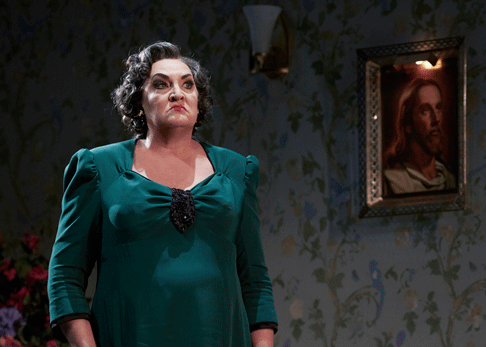 Victoria Livengood (Kabanicha)
Victoria Livengood (Kabanicha)
Kàt’a’s dreams are the key to look and dramaturgy of Patrick Nolan’s production. The danger for an updated, Americanized Kàt’a is implausibility: how can the love even of a timid small-town girl and a feckless rich boy be thwarted so thoroughly the era when Rosalind Russell, Ginger Rogers, and Betty Grable are setting the tone for young American girls’ behavior every weekend at the movie palace?
But this Kàt’a isn’t just a dreamer: she’s all dreamer. When life hands her lemons like mom-in-law Kabanicha (Victoria Livengood, a church lady who doesn’t mind a smoke, drink, or cuddle behind closed doors) and husband Tichon (Nicky Spence, a boozy bullpup without a bite) she incorporates them as dream enemies, and finds a dream prince handy in the form of Boris, (Joseph Dennis), lollygagging and at loose ends in the provinces
Ms. Moore is a mature woman and Dennis is a young man, but the mismatch in ages only accents the absurd of their relationship, while their voices, more sumptuous and powerful than those of the second cast’s Corinne Winters and Scott Quinn give them ever greater emotional clout as the drama deepens.
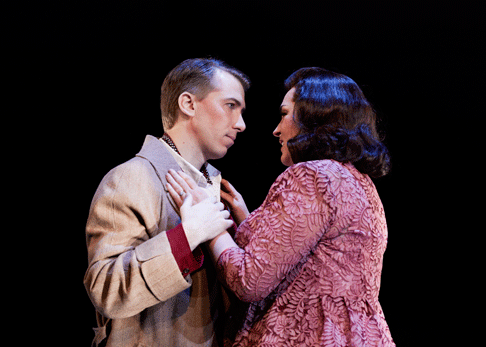 Joseph Dennis (Boris) and Melody Moore (Katya)
Joseph Dennis (Boris) and Melody Moore (Katya)
The power of the production is mightily enhanced from the pit. When a show is this well sung and acted throughout, it’s easy to forget the challenge for non-Czech singers in this repertory. I have no idea if a Czech speaker would find their delivery “authentic,” but they convinced me completely, and their attack and confidence can only be the result of the conducting of Oliver von Dohnànyi.
His is one of the proudest names of the last century in Central Europe. I do not know if Von Dohnànyi is related to the great musicians and statesmen whose name he shares, but his artistry is worthy of his name. Seattle Opera and Seattle audiences are lucky to have him.
They are also fortunate in the rest of the cast. The thoughtless young lovers Varvara and Kudrjas are taken in both casts by Maya Lahyani and Joshua Kohl in rather genre-generic musical-comedy second-couple fashion, but both sing very well; Nicky Spence and Stefan Skafarowsky make the most of their tiny roles. look forward to seeing them all in future productions.
Above all, let’s have Janacek Bring back: It’s been more than 25 year since we saw Cunning Little Vixen. Thanks to this fine show and above all to maestro von Dohnanyi, we’re prapared for The Macropolos Affair and From the House of the Dead!
Roger Downey
Cast and production information:
Conductor: Oliver von Dohnanyi. Kàt’a: Melody Moore/Corinne Winters; Boris: Joseph Dennis/Scott Quinn; Kabanicha: Victoria Livengood; Kudrjas: Joshua Kohl; Varvara: Maya Lahyani; Tichon: Nicky Spence; Dikoi: Stefan Skafarowsky; Glasha: Jennifer Cross; Feklusha: Susan Salas; Kuligin: Joseph Lattanzi. Seattle Opera chorus and Orchestra. Director: Patrick Nolan; Production design: Genevieve Blanchett; Lighting and digital effects: Mark Howett.
image=http://www.operatoday.com/17_Katya_JL_052.png image_description=Melody Moore (Katya) [Photo by Jacob Lucas] product=yes product_title=Káťa Kabanová in its Seattle début product_by=A review by Roger Downey product_id=Above: Melody Moore (Katya) [Photo by Jacob Lucas]All other photos by Philip Newton
March 18, 2017
Bampton Classical Opera Young Singers’ Competition 2017
The previous winners were mezzo-soprano Anna Starushkevych (2013) and soprano Galina Averina (2015). Bampton Classical Opera has a reputation for its commitment to young talent and a number of singers who have appeared on the Bampton stage have gone on to work with national companies such as The Royal Opera, English National Opera and Opera North.
The first round of the Bampton Classical Opera Young Singers’ Competition 2017 (closed sessions) will take place on 28 and 29 October in London. The public final will take place in the Holywell Music Room, Oxford, on Sunday 19 November at 6pm. Judges for the competition will be two renowned British singers: tenor Bonaventura Bottone and mezzo-soprano Jean Rigby.
Competitors can apply by downloading an application form and information document from www.bamptonopera.org or on request by emailing ysc@bamptonopera.org
Applications opened on 1 March 2017 and the entry deadline is 11 August 2017.
First prize £1,500 - Second prize £500. For the first time there will also be a £500 Accompanists’ Prize.
The winner of the first Young Singers’ Competition in 2013 was Ukrainian mezzo-soprano Anna Starushkevych and British soprano Rosalind Coad was the runner-up.
Since then Anna Starushkevych performed the role of Erato in Gluck’s Il Parnaso confuso and the title role in Bertoni’s Orfeo (UK première) for Bampton Classical Opera, both during summer 2014. In summer 2015 she sang the role of Ofelia in Salieri’s La grotta di Trofonio , also for the company. She is one of the soloists on a new Resonus Classics CD of song cycles by Pavel Haas, including the world première recording of Fata Morgana. Later this year Anna will sing the role of Matilda in Handel’s Ottone at both the Beaune Festival and Theater an der Wien.
Rosalind Coad was a Scottish Opera Emerging Artist from 2014-15 and sang a number of roles for the company. Currently she is covering the role of Mélisande in Pelléas et Mélisande for Scottish Opera. Other performances have included Gianetta (L’Elisir d’Amore) and Clotilde (Norma) for Opera Holland Park. She sang the role of Daughter in the Bampton Classical Opera concert performance of Maurice Greene’s Jephtha in 2014.
In the Young Singers’ Competition 2015 Russian soprano Galina Averina won first prize and Welsh soprano Céline Forrest was the runner-up.
Since the competition Galina Averina sang the role of Atalanta ( Serse) for English Touring Opera in 2016. She is currently singing Pamina for Mid-Wales Opera, and will be performing at the London Handel Festival. She will be taking part in the young artists programme at this year’s Aix-en-Provence Festival and will return to English Touring Opera for next season’s autumn and spring tours.
Céline Forrest studied at the National Opera Studio in 2015/2016. Her opera training took her to Opera North and Welsh National Opera, where she worked with Graham Vick and Elaine Kidd. Recently she covered the role of Jessica in Welsh National Opera’s The Merchant of Venice by Tchaikowsky. She is currently working on the role of Mina in Verdi’s Aroldo for UCOpera.
This competition is open UK residents aged between 21 and 32 on 19 November, 2017.
image=http://www.operatoday.com/Anna%20Starushkevych.jpg image_description= product=yes product_title=Bampton Classical Opera Young Singers’ Competition 2017 product_by= product_id=Above: Anna StarushkevychFestival Mémoires in Lyon
Le Couronnement de Poppée
Klaus Michael Grüber's production of L'incoronazione di Poppea comes from the Aix Festival of 2000. The design was by visual artist/painter Gilles Aillaud (1928-2005), Grüber's frequent collaborator at West Berlin's Schaubühne (and opera houses in Berlin and elsewhere). It was a prestigious cast, Grenoble's Les Musiciens du Louvre in the pit with Marc Minkowski.
I remember being bored, very bored. For me, then, there was no hint of mythic-in-the-making.
Just now in Lyon's 870 seat Théâtre National Populaire it indeed became mythic, brought there not solely by messieurs Gruber and Aillaud, but also and possibly because of the Les Nouveaux Caractères (a French early music ensemble) and principally its conductor Sébastien d'Hérin, and the fourteen Solistes du Studio de l'Opéra de Lyon (its young artists program). We, all of us -- the cast and audience -- were enthralled.
Conductor d'Hérin drove the music of the words, Monteverdi's dramatic genius bursting into dramatic phrases, with the double continuo of Les Nouveaux Caractères melding a myriad of colors into the Monteverdi's unfettered catalogue of affects. It was never mere musical color, it was always word and phrase, a relentless concentration of affects from beginning to end.
Conductor d'Héron evoked a flowing sensuality of sound, and an obsessive drive that never allowed Poppea and Nerone's ambitions to falter, culminating in the sublime love duet where Grüber's actors cross and cross and finally line-up on the most abrupt and corrupt ending of all opera.
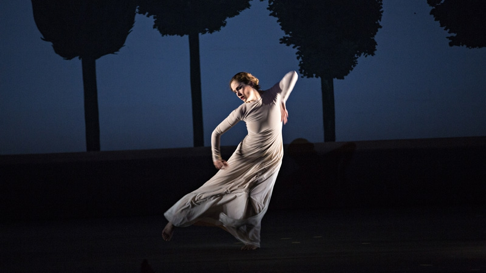 Josefine Göhmann as Poppea [Poppea photos copyright Jean-Louis Fernandez, courtesy of the Opera de Lyon]
Josefine Göhmann as Poppea [Poppea photos copyright Jean-Louis Fernandez, courtesy of the Opera de Lyon]
Director Grüber was a disciple of Giorgio Strehler. He bases much of what he does on Strehler's minimalistic principles and physical theater convictions. Gruber creates a theatrical language of abstractions, both in positioning and posturing. It is entirely presentational, eschewing all sense of an actual world, remaining always an imaginary, artistic world where the word itself is the only reality. Designer Aillaud's flat scenery visually embraces Grüber's artistic spaces to the fullest.
Without the distraction of famous artists attempting to realize such arcane abstractions, we entered this theatrical world through the willing young singers of the Opéra de Lyon's studio, who without exception gave total performances. Especially effective were the Nerone of Lithuanian mezzo Laura Zigmantaite and German/Chilean soprano Josefine Göhmann who were the only of Grüber's actors required to realize a constant plasticity of simultaneous gestural and musical movement -- a kind of emotional puppetry. Both were consummate performers.
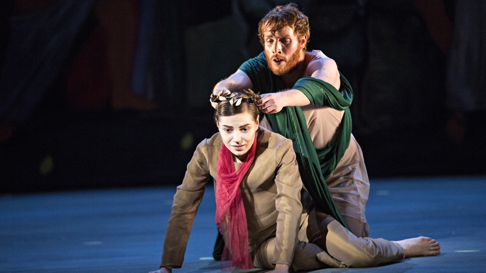 Laura Zigmantaite as Nerone, Oliver Johnston as Lucano
Laura Zigmantaite as Nerone, Oliver Johnston as Lucano
Excellent as well were the Seneca of Polish bass Pawel Kolodziej and the Ottavia of Finnish mezzo Elli Vallinoja. There were many memorable scenes, among them the spellbinding duet as Nerone expounds the sensual splendors of Poppea to his poet friend Lucano, sung by English tenor Oliver Johnston. And as well every scene with Poppea's nurse Arnalta, sung by French tenor André Gass.
Much praise for the success of this revival must be attributed to stage director Ellen Hammer, a directorial collaborator of Klaus Michael Grüber throughout his career. Mme. Hammer however in her program booklet remarks reveals herself needlessly pretentious as well as condescending to these superb young artists.
Cast and Production Information Poppea: Josefine Göhmann; Drusilla / Virtu: Emilie Rose Bry; Nerone: Laura Zigmantaite; Ottone: Aline Kostrewa; Arnalta: André Gass; Damigella: Amore Rocio Perez; Fortuna / Valletto: Katherine Aitken; Famigliare / Pallade: James Hall; Famigliare / Mercurio / Soldato: Brenton Spiteri; Littore / Liberto: Pierre Héritier; Ottavia: Elli Vallinoja; Seneca: Pawel Kolodziej; Lucano / Soldato Oliver Johnston; Famigliare Aaron O'Hare. Orchestra: Les Nouveaux Caractères. Conductor: Sébastien d'Hérin; Mise en scène: Klaus Michael Grüber; Revival director: Ellen Hammer; Décors: Gilles Aillaud; Re-creater of sets: Bernard Michel; Costumes: Rudy Sabounghi; Lighting: Dominique Borrini. Théâtre National Populaire, Lyon, France, March 16, 2017.
Elektra
By definition any Ruth Berghaus production is mythic, and not just because this mega famous stage director was intimately associated with Bertolt Brecht's Berliner Ensemble and his (and East Germany's) didactic Epic Theater. Mme. Berghaus thinks and acts in epically scaled proportions.
Like her early mentor Walter Felsenstein (founder of East Berlin's Komische Oper), Mme. Berghaus insisted on an equal balance of the musical and theatrical elements of opera. This in the light of "regietheater" (which she more or less founded) wherein the director is free to modify period, locale, even the story itself to didactic ends. At the same time the music and text (usually) are sacrosanct, and must not be altered.
All this plays out brilliantly in this 1986 production of Elektra from Dresden's Semperoper, where it remained in the repertoire until 2012. The orchestra sits, dramatically, on the stage! The Semperoper pit simply could not accommodate Strauss's 49 winds and percussion players, plus strings (only 50 in Lyon -- a minimum number, and certainly the Opéra Nouvel's pit would burst even with that number). [Note that there exists a much used reduced orchestration of Elektra for approximately 70 total players.]
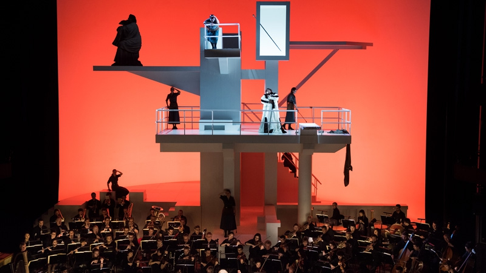
Strauss deemed that an expanded orchestra is necessary to create the colors necessary to his telling of this Greek tragedy, thus it becomes an absolute necessity for a Berghaus production. With this outsized orchestra needing to sit on the stage Elektra's cellar could only perch above the orchestra. So Mme. Berghaus simply transforms Elektra's prison into a perch from which the sisters see a world beyond their imprisonment and terror, and from which they search their salvation in the person of their brother Oreste who will murder his and their mother.
It becomes therefore perfect Brechtian Epic Theater -- theater as a catalyst for change and renewal. With the orchestra on yhe stage displacing traditional operatic staging convention the primary Brechtian precept was present -- distancing the spectator (and I indeed struggled with this distance) from the work of art in order that he might understand, and presumably act on its message rather than to be absorbed into its world.
These many years later, and in a different and far advanced social and political structure I struggled to transform such didactic theater into contemporary art. For me however it remained very much a period piece, evoking impotent nostalgia for the avant-garde of the ephemeral ideals of a failed world, and a longing for real, contemporary avant-garde operatic art.
This Lyon revival was very well cast, and convincingly conducted. It was a quite powerful if cold experience.
Cast and Production Information Elektra: Elena Pankratova; Clytemnestre: Lioba Braun; Chrysothémis: Katrin Kapplusch; Egisthe: Thomas Piffka; Oreste: Christof Fischesser; Le précepteur d'Oreste: Bernd Hofmann; La confidente de Clytemnestre: Pascale Obrecht; La porteuse de traine: Marie Cognard; Un Jeune serviteur: Patrick Grahl; Un Vieux serviteur: Paul-Henry Vila; La Surveillante Christina Nilsson. Orchestra of the Opera de Lyon; Solistes du Studio de l'Opera de Lyon. Conductor: Hartmut Haenchen; Mise en scène: Ruth Berghaus; Revival stage director: Katharina Lang; Décors: Hans Dieter Schaal; Costumes: Marie-Luise Strandt; Lumières: Ulrich Niepel. Opera Nouvel, Lyon, France, March 17, 2017.
Tristan et Isolde
East Germany's and now Germany's most famous playwright after Bertold Brecht is Heiner Müller. His staging of Wagner's Tristan und Isolde was a part of the 1993 Bayreuth Festival, and is his only staging of an opera. Though a prolific playwright and dramaturg becoming finally the artistic director of the Berliner Ensemble, he himself staged few plays and then only in the last 15 years of his life.
Unlike Brecht or Ruth Berghaus theater for Müller is not didactic, nor does he promote social or political agenda (though it may be referenced). Rather he introduced multiple perspectives into his theater works, destroying linear storytelling and, in fact, drama itself in search of abstracted associations. In this sense Müller defined theatrical post-modernism for his generation.
It is no surprise then that Müller chose to stage Tristan und Isolde, composed as it is of three protagonists (including King Mark) whose life situations intersect only at brief moments of action, but whose personal dramas, or traumas are powerful and poetic, and associate only by chance.
Müller's collaborator for the Tristan production was avant-garde designer Erick Wonder who with Müller locked the opera's lengthy monologues in a huge, closed box. Theater's "fourth wall" was in fact an often visible scrim, referenced early in the evening by Isolde placing her hands directly on the [not merely imaginable, but quite real] fourth wall to indicate its boundary and, in fact, significantly, the box's separation from the audience itself.
The famed love scene of the second act was realized as two simultaneous monologues, the lovers met by placing their hands on an imaginary wall that isolated each from the other. The dreamy intensity of the love duet was rendered by the protagonists kneeling side by side, in separate prayers to love.
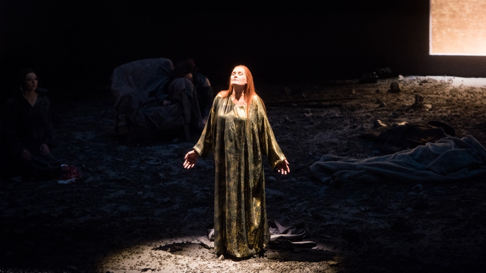 Ann Petersen sings the "Liebestod"
Ann Petersen sings the "Liebestod"
The stage box became Tristan's decaying chateau in the delirium, its floor now strewn with dead leaves, Tristan resting in a dilapidated easy chair. Blocks of intense color, first red then gold heralded Isolde who shed several cloaks to deliver, finally her "Liebestod" in a golden gown, motionless, breaking through the fourth wall at last, singing directly to us.
The squares of color, large and small, throughout the opera -- on the walls, floor and ceiling -- visually created the suggestion of separated emotional spaces, reinforcing the abstractions of the dramatic spaces of the protagonists. The staging itself kept each of the protagonists in oblique, abstractly linear movement, intersecting only in the rare moments of action. If nothing else the production itself made a splendid evening of abstract visual art, and this alone was sufficient to propel it to mythic status.
Separating the protagonists, isolating each in a unique space placed enormous responsibility on its artists to create individual theatrical and musical worlds -- it is certainly a very difficult requirement, and it may simply have demanded too much. If hopefully this responsibility was fulfilled in Bayreuth back in 1993 it was not just now in Lyon. On the stage the singers were left helplessly on their own, conductor Hartman Haenchen absorbed in a quite detailed reading of Wagner's score, a reading that excluded the sweep of sensual poetry, the dynamic force of poetic delirium and the depth of tragic, Romantic love.
After the orchestral excesses of Ruth Bergman's Elektra, the Opéra de Lyon opted for 69 players in the pit (who indeed sounded like many more), whose apparent artistry was welcome indeed in this otherwise frustrating evening.
Cast and Production Information Tristan: Daniel Kirch; Isolde: Ann Petersen; Roi Marke: Christof Fischesser; Kurwenal: Alejandro Marco-Buhrmester; Melot: Thomas Piffka; Brangäne: Eve-Maud Hubeaux; Le Jeune Matelot / Le Berger: Patrick Grahl; Un timonier: Paolo Stupenengo. Chorus and Orchestra of the Opera de Lyon. Direction musicale: Hartmut Haenchen; Mise en scène: Heiner Müller; Réalisation de la mise en scène: Stephan Suschke; Décors: Erich Wonder; Recréation des décors: Kaspar Glarner; Costumes: Yohji Yamamoto; Lumières: Manfred Voss; Recréation des lumières: Ulrich Niepel. Opera Nouvel, Lyon, France, March 18, 2017.
Michael Milenski
image=http://www.operatoday.com/Elektra_Lyon1.png
product=yes
product_title=Festival Mémoires (Poppea, Elektra, Tristan) in Lyon
product_by=A review by Michael Milenski
product_id=Above: Elena Pankratova as Elektra, Christof Fischesser as Oreste [Elektra and Tristan photos copyright Stofleth, courtesy of the Opéra de Lyon]
Handel's Partenope: surrealism and sensuality at English National Opera
Silvio Stampiglia’s libretto contains the requisite amorous knots endured by classical kings and queens. Partenope, the founding Queen of Naples, is courted by three royal lovers: Arsace, Prince of Corinth, who is first in line for Partenope’s affections; the affectatious Armindo, Prince of Rhodes; and Emilio, Prince of Cumae, who, spurned by the Queen, determines to make war not love. Arsace’s abandoned fiancée, Rosmira, disguises herself as Eurimene in order to pursue her betrayer, and becomes Partenope’s fourth suitor.
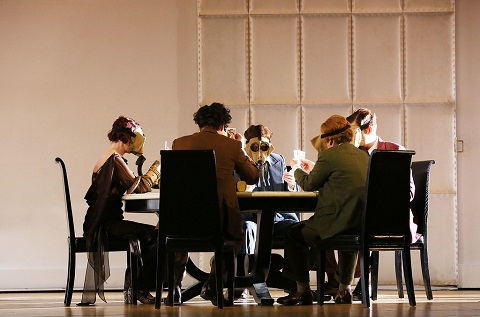 ENO Cast. Photo credit: Donald Cooper.
ENO Cast. Photo credit: Donald Cooper.
Director Christopher Alden largely ignores the historic context and plumps instead for ‘Partenope the sailor-serenading siren’ who, so the myth goes, cast ashore on the Neapolitan coast after throwing herself into the sea in her despair at not having been able to sing Ulysses to his death. Alden and his excellent design team - Andrew Lieberman (set), Jon Morrell (costume), Adam Silverman (lighting) - set the action in a Parisian salon of the 1920s at the height of Surrealism. Ironically, ‘Partenope’ means ‘virgin’ in Greek, for it’s the bedroom which is the battleground here.
The Surrealists sought to overthrow society’s ‘rules’ and demolish its reliance on ‘rational thought’. Their philosophy - as summed up by artist-at-the-helm, André Breton - might seem potentially risky for a director seeking to untangle the libretto and offer a credible context: ‘thought expressed in the absence of any control exerted by reason, and outside all moral and aesthetic considerations.’
Tapping the subconscious and liberating the creative power of the unconscious mind could prove profitable though. Alden turns Partenope into Nancy Cunard, in whose art deco apartment various artists gather to drink, play cards, tap dance, twirl batons, distastefully prat about with gas marks and bayonets, graffiti the pristine white walls with Matisse-squiggles and lewd symbols, and pay ardent homage to their hostess. A spectacular sweeping staircase is a death-trap to the inebriated, and if the hedonists don’t slip on the banana skins that are literally thrown around the stage then there’s the risk of getting locked in the lavatory (toilets dominate the second Act, complementing the smutty colloquialisms of Amanda Holden’s translation). By Act 3, the sharp suits of Act 1 have been abandoned for pyjamas and various states-of-undress.
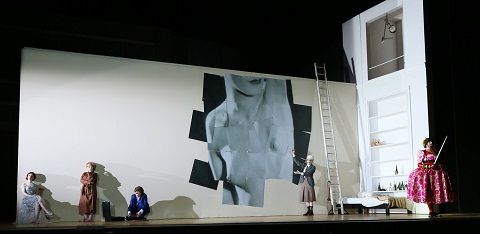 ENO cast. Photo credit: Donald Cooper.
ENO cast. Photo credit: Donald Cooper.
Emilio is now photographer Man Ray. I presume that the photographs that he obsessively snaps - of artfully piled bodies and kinky indulgences - are designed to ‘expose’ the protagonists to reality. In Act 3 Emilio climbs a ladder and slowly assembles a collage-mural: what starts off looking like a monochrome of Matisse’s ‘The Snail’ is revealed as Man Ray’s 1934 ‘Nude Bent Forward’.
The design is certainly chic and Silverman’s chameleon-like lighting is superbly evocative. But, there’s no clear raison d’être. Handel’s humour is underpinned by honesty: even Partenope’s desire is sincere, if itinerant, and Armindo values fidelity - as he sings (in Holden’s words), in ‘Nobil core, che ben ama’: ‘Faithful lovers wisely ponder/ that if fancy never wanders,/ they’ll achieve a life sublime./ Constancy’s a thing to cherish;/ truthful love need never perish/ e’en until the end of time.’
Alden’s concept is not true to such avowals. His is a world of artifice: sophisticated but superficial. There’s a lack of emotional engagement between his characters, and twixt them and us: we simply don’t care about their urbane game-playing.
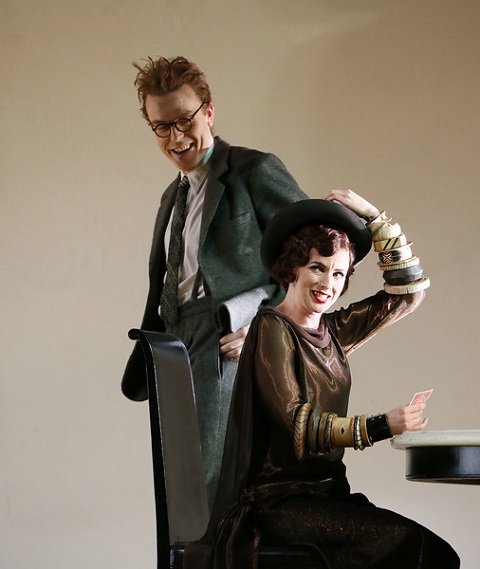 Rupert Charlesworth (Emilio) and Sarah Tynan (Partenope). Photo credit: Donald Cooper.
Rupert Charlesworth (Emilio) and Sarah Tynan (Partenope). Photo credit: Donald Cooper.
But, the superb performances of the ENO cast offer a compensating allure. As the eponymous Queen, Sarah Tynan poses and struts, preens and sings with classy aplomb: whether sporting the jangling bangles of a trouser-suited Nancy Cunard, or the natty top hat and tails of Marlene Dietrich, Tynan convey’s Partenope’s Amazonian self-belief and spirited sensuality: she’s in love with Love. Her soprano is quite light, but flexible and clear, sparkling but never hard-edged. After a slightly hesitant opening aria (conductor Christian Curnyn pushes the pace throughout) she crafted the phrases with style and hit the hemi-demi-semi-quavers with panache - even when asked to stoke an old stove during the florid ‘Qual farfalletta’ (Act 2) to imitate the flaming passion of Cupid about whom she sings.
Given that this opera requires its cast to sing their arias dangling from staircases, balancing astride toilet seats and while climbing ladders, it seems sadly ironic that tenor Robert Murray was forced to withdraw from the role of Emilia following a fall which left him with severe concussion (of course, we wish Murray a swift recovery). Rupert Charlesworth was an admirable last-minute replacement: his firm tenor raged and ranted with indignant wrath in ‘Barabaro Fato si’ - an extravagant diatribe against fate - when he found himself imprisoned in Partenope’s toilet.
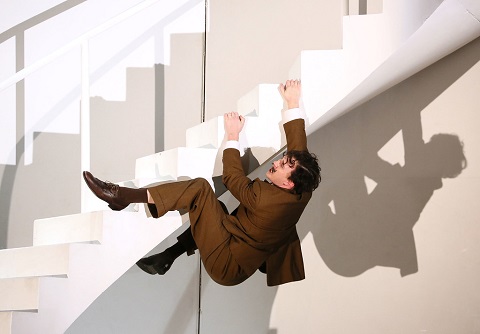 James Laing (Armindo). Photo credit: Donald Cooper.
James Laing (Armindo). Photo credit: Donald Cooper.
As Armindo, James Laing survived the Chaplin-esque clowning required of him without physical or vocal mishap - ‘Volio dire al mio tesoro’ was sung while swinging perilously from the curving staircase. Laing was rewarded for enduring the ‘funny business’: Armindo gets his girl in the end.
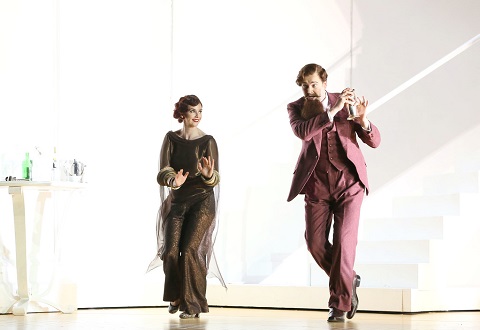 Matthew Durkan (Ormonte) and Sarah Tynan (Partenope). Photo credit: Donald Cooper.
Matthew Durkan (Ormonte) and Sarah Tynan (Partenope). Photo credit: Donald Cooper.
Looking like Lytton Strachey, bass Matthew Durkan was effective as Partenope’s chief guard, Ormonte, dispatching the coloratura cleanly and firmly. The role of Rosmira was sung impressively by rising star Stephanie Windsor Lewis; the ENO orchestra’s horn section made a colourful contribution to her aria, ‘Io seguo sol fiero’.
It was Patricia Bardon, though, as the pompous chancer Arsace, who stole the show. During the first run of the production in 2008, Bardon sang Rosmira; here she was a lustrous Arsace whose humiliation and sorrow were heartbreakingly conveyed in the slow, affecting ‘Ch’io parta? Sì crudele’ (Act 3).
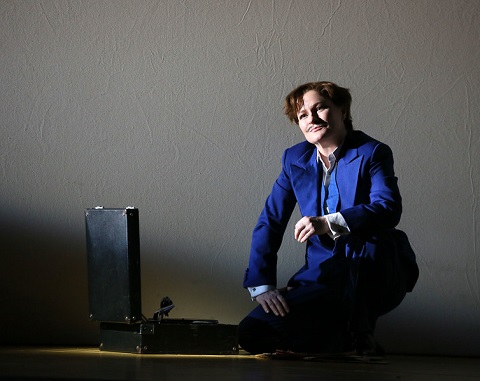 Patricia Bardon (Arsace). Photo credit: Donald Cooper.
Patricia Bardon (Arsace). Photo credit: Donald Cooper.
Charles Burney judged Partenope to be ‘among the best of Handel’s dramatic productions’ and on the evidence of the score and the singing enjoyed here it’s hard not to agree. But, while Alden gives us luxury, lightness and louche-ness, the pleasures and pains of love - something of Così’s paradoxes? - are replaced by a Surrealist dream which doesn’t quite satisfy.
Claire Seymour
Handel: Partenope
Sarah Tynan - Partenope, Patricia Bardon - Arsace, James Laing - Armindo, Rupert Charlesworth - Emilio, Stephanie Windsor Lewis - Rosmira, Matthew Durkan - Ormonte; Christopher Alden - Director, Christian Curnyn - Conductor, Andrew Lieberman - Set Designer, Jon Morrell - Costume Designer, Adam Silverman - Lighting Designer, Orchestra of English National Opera.
English National Opera, Coliseum; Wednesday 15th March 2017.
image=http://www.operatoday.com/ENO%20Partenope%20Sarah%20Tynan%205%20%28c%29%20Donald%20Cooper.jpg image_description=Partenope, English National Opera product=yes product_title=Partenope, English National Opera product_by=A review by Claire Seymour product_id=Above: Sarah TynanPhoto credit: Donald Cooper
March 15, 2017
Christoph Prégardien and Julius Drake at the Wigmore Hall
Prégardien and Drake’s November 2015 release Poetisches Tagebuch - which comprises lieder to poems by Ernst Konrad Friedrich Schulze (1789-1817), followed by settings of poems that are drawn together by their shared imagery of absence, aging, winter and death - received Grammy Award nomination for Best Classical Vocal Solo and received the German Critics Award in 2016. The programme presented at the Wigmore Hall essentially reprised this disc, with the addition of a single extra song in the second half of the recital.
The performers’ consummate musicianship and professionalism was evident throughout. Prégardien cuts a noble figure on stage, immaculately dressed, stylish but unshowy in manner - the embodiment of dignified poise. But, such self-composure, and the singer’s use of a score, at times distanced the tenor from the audience - I do not think that my location at the rear of the Hall was a factor, as I have not previously found this to be an impediment to strong, direct communication.
There were many musical compensations for the occasional absence of dramatic intensity, however, not least Prégardien’s even, dulcet tone and graceful phrasing. The musical details were unfailingly observed but articulated with subtlety. Naturally, the German singer’s diction is excellent, but at times he seemed satisfied to rely upon precise and careful enunciation to convey meaning, and did not use his voice to explore the inferences inherent in textual detail - the sounds and rhythms of the words. And, the soothing evenness, though alluring, can be a limitation: as the recital progressed I longed for more contrast of colour, dynamics and weight.
Technically assured, Prégardien demonstrated impressive vocal control, employing rubato and flexibility with confidence and discernment. He found the higher lying lines more challenging, however, and made more extensive use of the head-voice than I would have expected, with the result that at the top his tenor lacked roundness. Such ethereality may be a fine vehicle for embodying yearning and absence - frequent moods within these texts - but became rather monotonous and, when repeated, the expressive weight of such gestures diminished.
Also, while I admit that it’s a matter of personal preference, I found that the tempi adopted in several songs was a little on the slow side. In the slower lieder there was a danger that unhurried probing or reflective quietude would lapse into dreamy oblivion, and the more agitated items did not acquire the compelling momentum that the diverse, heightened and unpredictable emotions of their dramatic narratives demand.
Perhaps it’s just the case that I prefer the extreme anguish that Ian Bostridge brings to these lieder, or the probing intensity of Mark Padmore. And, it should be noted that Julius Drake was alert to every nuance and suggestion in the piano parts, always astonishing sensitive in supporting Prégardien but also colouring and dramatizing.
Schubert’s nine settings of poems by Ernst Schulze were composed shortly before Winterreise (1827). They form a quasi-cycle of loss and obsessive longing; indeed, when including the songs in Vol.18 of Hyperion’s Complete Schubert Edition, pianist Graham Johnson proposed titling them as a group,Auf den wilden Wegen. The songs have their origin in Schulze’s unrequited passion for two sisters, Cäcilie (who died of tuberculosis) and Adelheid Tychsen. His ‘poetic imaginings’ were brought together in Schulze’s Poetisches Tagebuch, before he himself died of tuberculosis at the age of 28.
Schubert’s Schulze settings are not his best-known lieder, but the first song, ‘Auf der Bruck’ (On the bridge) is one of two - the other being ‘Im Frühling’ - which appear frequently on recital programmes. Drake’s opening bars were stirring and energised. His control and crafting of the dynamic contrasts - the resonant octaves in the bass veer wildly from loud to soft, while fully voiced, quiet chords reiterate in the right-hand - created urgency and agitation. These turned to excitement in the second stanza, as Prégardien imagined the wondrous sights to be viewed from the saddle of his galloping horse, and Drake’s sparkling trill underpinned his ‘joy’.
The evenness of Prégardien’s tenor was an asset in ‘Der liebliche Stern’ (The lovely star), creating a sense of the poet-speaker’s distance from the heavens above, the calm broken only by the slightest enrichening: ‘So wird mir von Wohl und Wehe’ (weal and woe trouble my heart). The major-minor fluctuations of ‘Im Walde’ (D834) (In the forest) brought unrest to the poet-speaker’s journeying and, without ever noticeably quickening the tempo the performers evoked an accelerating force which pushed the frustrated traveller onwards in search of a never-to-be-regained love. Prégardien showed sensitivity to the text here, in the repetition of ‘nimmer’ - ‘Wohl hing ich nimmer so an euch!’ (I never drew so close to you) - and in the subsequent ‘Um Mitternacht’, where his soft head-voice captured the radiance of the night stars which sparkled in Drake’s beautifully delicate accompaniment. Later, an injection of strength conveyed the poet-speaker’s pride and self-confidence as he prepared to brave any storm or tempest to see his beloved’s image once again.
Schulze, recognising that his obsession was pathological, occasionally issued a poetic cry for ‘courage’, and ‘Lebensmut’ calls for a renewal of youthful strength - a bold defiance of mental frailty which Drake’s springing rhythmic counter-forces duly delivered, confirming the voice’s firm assertion ‘O, wie dringt das junge Leben/Kräftig mir durch Sinn und Herz! (How vigorously young life pulses through my mind and heart!). The piano’s insouciant postlude suggested, however, that the poet-speaker’s confidence was self-deceiving. ‘Lebensmut’ was written one day after ‘Im Frühling’, and one cannot think of a greater contrast than between the former’s surging vigour and the latter’s wistful introspection. Indeed, initially I found ‘Im Frühling’ almost too meditative, in danger of slipping into a dream in which the gleams of spring that the poet describes would lose substance and presence. But, the unusual harmonies which accompany the poet-speaker’s thoughts of strife and sorrowful solitude created greater movement towards the end of the lied, making place and mood more palpable.
The ‘deep sorrow’ of ‘Tiefes Leid’ was followed by the ‘dark delusions’ (‘dunklen Wahn’) of ‘Über Wildemann’ but in the latter Prégardien’s tenor had neither the strength nor range of colour to suggest a Byronic embracing of the roaring winds and wintry snow such as characterises Schulze’s frenzied poem. Moreover, prudence perhaps led Prégardien to pull back from the slightly faster tempo that might have conjured the desperate urgency of the vocal lines as the phrases crescendo to their climactic peaks.
The three Rückert settings that opened the second half of the recital introduced a fresh and absorbing complexity. ‘Daß sie hier gewesen’ (That she was here) demonstrated the sheer sweetness of Prégardien’s tenor, evoking the fragrant scents with which the wind teases the poet-speaker. In ‘Greisengesang’ (Old man’s song) the singer used the text more effectively and moved well between registers. The poignant simplicity of Drake’s introduction to ‘Du bist die Ruh’ captured the poem’s blend of peace and longing. Prégardien shaped the melody with poise and constancy, but, while the voice was secure at the challenging rise in the final stanza, ‘Dies Augenzelt/Von deinem Glanz/Allein erhellt’ (This temple of my eyes is lit by your radiance along), he held back from delivering the crescendo of ardour for which Schubert asks.
At this point, ‘Der Tod und das Mädchen’ interrupted the sequence of recorded Poetisches Tagebuch songs, following almost segue; were Drake and Prégardien suggesting that the maiden summoned by the poet-speaker in ‘Du bist die Ruh’ rejects her obsessive admirer, ‘Vorüber! Ach, vorüber!/ Geh, wilder Knochenmann!’ (Away! Ah, away! Away, fierce man of bones!’), or that he will lose her to Death?
After the lingering pathos of these opening songs, the surging ripples of ‘Im Walde’ (D708) were a welcome rush of vigour and the narrative structure of this lied was well articulated. ‘Nacht und Träume’ was fittingly reverential and pensive, but again the slow tempo and Prégardien’s prioritising of melodic lyricism lessened the impact of the inferences carried by the sounds of the words themselves. The tenor was an engaging story-teller in ‘Fischerweise’ but this brief window of lightness was rapidly pushed aside by the angry despair of the grave-digger in ‘Totengräbers Heimweh’ (Gravedigger’s longing) - a powerful monologue of existential yearning. The final lied, ‘Winterabend’ (The winter evening), seemed to return us to the spirit of Schulze’s fervent poet-speaker, assured that he will attain his heart’s desire and thus content to ‘Denk’an sie, an das Glück der Minne,/ Seufze still, und sinne und sinne’ (Think of her and love’s happiness, sigh in silence, and muse and muse).
This was not a lieder recital to leave one feeling emotionally wrought, having shared the pain and wretchedness of Schubert’s lovers and wanderers, but it was a recital to prompt reflection. Returning home, my conversation with my German-speaking guest turned to diverse concerns: the skill with which Rückert manipulates language; the disturbing image of the grave-digger’s self-destructive denial of the world; the German concept of Bildung - the cultivation of the ‘self’. So, this was a recital to inspire one to muse.
Claire Seymour
Christoph Prégardien (tenor), Julius Drake (piano)
Franz Schubert: ‘Auf der Brücke’ D853, ‘Der liebliche’ Stern D861, ‘Im Walde’ D834, ‘Um Mitternacht’ D862, ‘Lebensmut’ D883, ‘Im Frühling’ D882, ‘An mein Herz’ D860, ‘Tiefes Leid’ D876, ‘Über Wildemann’ D884, ‘Dass sie hier gewesen’ D775, ‘Greisengesang’ D778, ‘Du bist die Ruh’ D776, ‘Der Tod und das Mädchen’ D531, ‘Im Walde’ D708, ‘Nacht und Träume’ D827, ‘Fischerweise’ D881, ‘Totengräbers Heimweh’ D842, ‘Der Winterabend’ D938.
Wigmore Hall, London; Tuesday 14th March 2017.
image= http://www.operatoday.com/2_ChristophPregardien_CR_MarcoBorggreve.jpg image_description=Christoph Prégardien (tenor), Julius Drake (piano) at the Wigmore Hall product=yes product_title=Christoph Prégardien (tenor), Julius Drake (piano) at the Wigmore Hall product_by=A review by Claire Seymour product_id=Above: Christoph PrégardienPhoto credit: Marco Borggreve
March 14, 2017
La Tragédie de Carmen at San Diego
In 1983 Stage Director Peter Brook, in collaboration with writer Jean-Claude Carrière and composer Marius Constant, pared down the French grand opera to its bare essentials and presented La Tragédie de Carmen, a ninety-minute version of the story.
Rather then enumerate all the characters and musical numbers omitted, I will simply list the main characters and mention much of the music we heard at the Balboa Theatre on Friday evening. The characters were Carmen, Don José, Zuniga, Micaela, Escamillo, Garcia, and Lillas Pastia. If you are wondering who Garcia is, he is Carmen’s husband. He is mentioned in the Proper Merimée’s original book but not in the opera. Brook’s Carmen was no longer a glamorous gypsy and she had lost her factory job. However, she still managed to divert José’s attention from Micaela even though the latter sang with lustrous tones. The country girl put up a fight, however, and in this version of the story she had more spunk than in the grand opera.
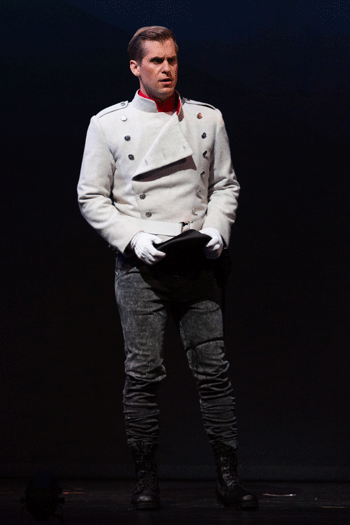 Adrian Kramer as Don Jose
Adrian Kramer as Don Jose
With no chorus of soldiers in the background and no children imitating them, the focus was on the rivalry and its results. Carmen fascinated José with the "Habanera" but the orchestra had been pared down to a fifteen-member chamber ensemble. Thus, she did not need to have the big operatic voice we normally hear singing over a full orchestra. Peabody Southwell sang Carmen with a sultry sound and played up her intense sexuality. Her "Seguidilla' was delightful, her "Gypsy Song" enchanting, and there were no extra soldiers to harass her.
The memento she gave José, sung by tenor Adrian Kramer, was a red knitted stocking, not a flower. Nevertheless, he held it as he sang a beautifully lyrical "Flower Song." When the story moved to the inn, we met Max Cadillac as Lillas Pastia, an amusing female impersonator and hostess extraordinaire. At one point, Carmen was involved in a threesome with José and Lillas. Then we understood that the soldier’s thoughts had long since left his elderly mother and the village girl who expected to marry him.
Of course with a chamber orchestra and many fewer characters, there were no ensembles in the La Tragédie. Gone were the smugglers and their wonderful quintet. Instead we saw raw emotion, love and hate. Carmen had become theater. A fine actor as well as a singer, Adrian Kramer painted pictures with the colors in his voice. José, his possessive, psychotic character, was as essential to the story as Carmen herself. His tragedy grew out of his own actions, however. If only José had not left his village, he and Micaela might have had a chance at happiness, but after his trip to the big city, he, like many others, would never go back.
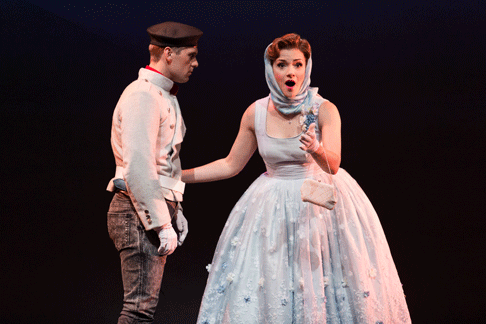 Adrian Karmer (Don Jose) and Andriana Chuchman (Micaela)
Adrian Karmer (Don Jose) and Andriana Chuchman (Micaela)
Bass baritone Ryan Kuster gave a thoroughly pleasing performance of Escamillo with a full orchestra at Arizona Opera not too long ago. In San Diego his vocal range seemed to be a bit restricted, but it may be that some of the Toreador's notes are written lower in La Tragédie. He was a spectacular matador, however, and for a while it seemed as though Carmen belonged on his arm. Unfortunately, the bull killed him early on and his bloody corpse left the ring in an open cart.
Brook’s Carmen is a young girl eager to make money any way she can in the early scenes but she believes in fate and, for that reason, she understands that sooner or later she will meet her destiny. She is younger and much less of a glamor girl than Bizet’s Carmen, but she will intrigue patrons who are more interested in character and conflict than in the spectacle offered by grand opera.
Maria Nockin
Cast and production information:
Conductor, Christopher Rountree; Director, Alexander Gedeon; Scenic and Video Designer, Yuki Izumihara; Costume and Video Designer, Adam Alonso; Lighting Designer, John A. Garofolo; Fight Director, Brian Byrnes; Don José, Adrian Kramer; Carmen, Peabody Southwell; Micaela, Andriana Chuchman; Zuniga/Garcia, Anthony Nikolchev; Lilla Pastia, Max Cadillac; Escamillo, Ryan Kuster.
image=http://www.operatoday.com/KarliCadel-SDOpera-TragedyCarmen-4094.png image_description=Peabody Southwell as Carmen [Photo by Karli Cadel] product=yes product_title=La Tragédie de Carmen at San Diego Opera product_by=A review by Maria Nockin product_id=Above: Peabody Southwell as CarmenPhotos by Karli Cadel
Kasper Holten's farewell production at the ROH: Die Meistersinger von Nürnberg
It is also an opera that performs, rather than theorises, Wagner’s claim that his operas will fulfil his revolutionary concept of a teleological art: an art that would save the future world from the philistinism and barbarism of the present. So, Wagner might have said that Meistersinger is an opera about ‘me, authority and tradition’.
Holten’s new production is ‘revolutionary’ in its own way, turning the opera inside out, back to front and even (literally) upside down in one climactic vignette of cultural anarchy. Wagner’s own words, ‘Kinder, schafft Neues!’ (Children, create new things!) preface the programme-book synopsis that Holten has penned - and, later, reappear as graffiti on a toppling wall - so, is Holten telling us that he is taking up Wagner’s cause?
Wagner transports the audience back to the guild culture of 16th-century Nuremberg, opening Act 1 inside St. Catherine's Church where a service is just ending. Holten and his designer Mia Stensgaard shun historical and geographical authenticity and create a single set - albeit one which revolves to destroy its own theatrical illusion of veracity - which is well-suited to the opera’s scenes of pomp and ceremony but less apt for the more intimate episodes which probe into the hearts, minds, homes and streets of the citizens of Nuremberg.
We find ourselves in a grand, panelled room - a gentlemen’s club or Masonic hall - in the early decades of the 20th century. Glamorous and sophisticated, this stately chamber is a homage to art deco geometric angularity, with its polished parquet floor, decorative plinths topped with lyres, birds and statuettes, and ornamental indoor trees. It’s certainly handsome to look at and, as the ROH Chorus launched into their lusty rendition of a Lutheran pastiche, the flashes of chrome and nickel momentarily suggested vast organ pipes - which helped to push aside the question of what a church choir was doing in a private members’ club. The centrepiece is a huge raised ‘throne’ of burnished copper, which put me in mind of, alternately, an outsized beer tankard and the F.A. Cup.
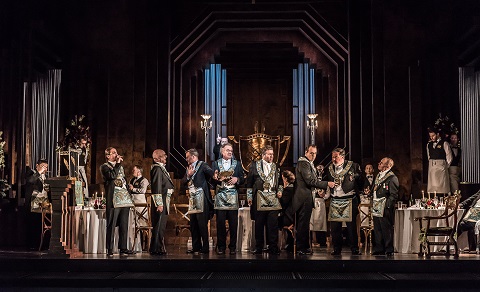 Photo credit: Clive Barda.
Photo credit: Clive Barda.
When a team of waiters arrives to set up, under the supervision of Major Domo David and Stewardess Magdalene, dinner tables for the arriving club members, we slip back a decade or two into the Edwardian opulence of Downton Abbey. The tables are laden with flickering candles, glittering goblets and red floral decorations. Indeed, everyone seems more interested in what’s for dinner - Beckmesser picks at melon and serrano ham - than the essential aesthetic dilemma which troubles Wagner’s guildsmen, ‘what is beautiful?’
And, herein lies a problem with Holten’s conception. The real 16 th-century Meistersingers, having created an idealised lineage stretching back to the twelve great masters who represented the first flowering of German culture in the 13th century, were now concerned that their traditions were falling into disrepair. Sachs and Beckmesser tussle how these traditions might be saved and maintained; Veit Pogner addresses the decaying state of art in his presentation to the Guild Meeting, offering his daughter as a prize that can inject new life into a dying art form.
In Holten’s theatrical world, however, the prize-song competition seems irrelevant, even incongruous: when Pogner ‘sells’ his daughter, Eva is more a trophy Eve than a muse of Parnassus. When a greasy looking Walther arrives, his rock-band t-shirt, out-sized coat and cool shades are an eyesore amid the formal regalia of the club, as Holten reverses the class-relationship between Wagner’s courtly knight and the guildsmen.
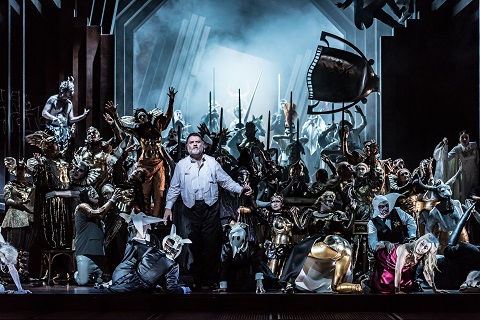 Photo credit: Clive Barda.
Photo credit: Clive Barda.
Act 2 does not take us out into the streets and among the people: Sachs seems to have set up shop in the club dining-room, and the ornamental planters have to do service for fragrant lime trees and verdant meadows. Given the incompatibility between set and action, stronger stagecraft is needed if we are to appreciate the Nurembergers’ lives and minds. Moreover, the end-of-act fracas between David and Beckmesser mushrooms into a vision of apocalypse worthy of Hieronymus Bosch: a riot of beasts and devils swarms the stage - Signe Fabricius’ movement direction is masterly - and the throne, already on a tilt, is ripped from its pedestal and spun aloft, as a tattooed, torch-bearing, cloven-hoofed Pan ineffectually calls the hour.
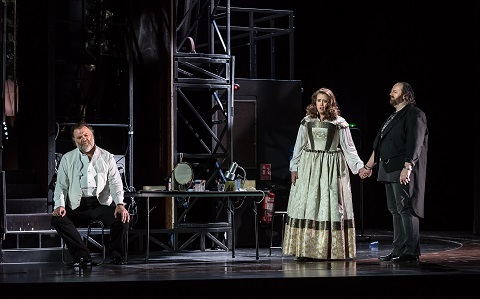 Bryn Terfel (Sachs), Rachel Willis-Sørensen (Eva), Gywn Hughes Jones (Walther). Photo credit: Clive Barda.
Bryn Terfel (Sachs), Rachel Willis-Sørensen (Eva), Gywn Hughes Jones (Walther). Photo credit: Clive Barda.
Act 3 appears to tell us that what we have just seen is ‘a dream’, of a theatrical kind, as the set swivels back to reveal its own ‘back-stage’. A slow revolve takes us full circle and by the end of the Act we are back in the gentlemen’s club for the Feast of St. John. Costume Designer Anja Vang Kragh indulges in hyperbolic pageantry: while the guildsmen, who perch on raked seating as if watching a dramatic performance, wear modern dress, the ‘mastersingers’ are an explosion of richly coloured finery and frippery, topped with pavement-slab mortar-boards. Again, the attention to detail is notable: Sachs even has a boot atop his golden staff. But, surely the vagrant-like Walther would not get past the doormen?
If there are some question marks over the logic and consistency of Holten’s concept, the cast score full marks all round for stamina. Byrn Terfel took a little while to get into his stride - his is quite a subdued Sachs - but by Act 2 he had the measure of Beckmesser, cobbling with sly insouciance during his serenade. And, though the relationships between Sachs, Walther and Eva at times lack clarity, Terfel skilfully conjured pathos in his scene with Eva. Sachs’ paean to ‘Holy German Art’ can seem like an unsettling volte-face, but Terfel’s imperious explanation of the need to preserve and continue the mastersingers’ art smoothed over the swerve.
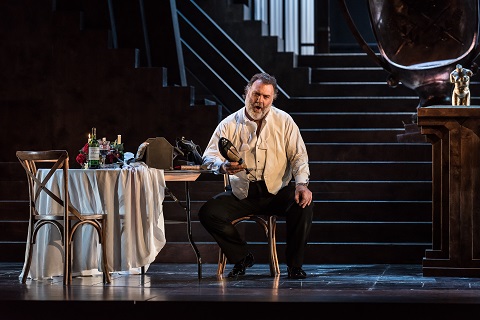 Bryn Terfel (Hans Sachs). Photo credit: Clive Barda.
Bryn Terfel (Hans Sachs). Photo credit: Clive Barda.
American soprano Rachel Willis-Sørensen is a creamy-voiced Eva; the richness and radiance of her voice conveys Eva’s surprising feistiness, as does Willis-Sørensen’s nuanced acting - even though she is saddled with a series of ghastly, unflattering costumes including a dress as sturdy as a battleship. If only her diction had been clearer; this was a weakness that was exacerbated by the clarity of Terfel, and that of Gwyn Hughes Jones as Walther von Stolzing.
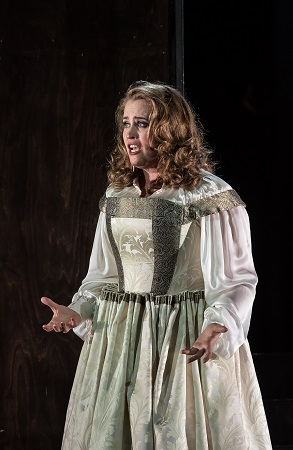 Rachel Willis Sørensen (Eva). Photo credit: Clive Barda.
Rachel Willis Sørensen (Eva). Photo credit: Clive Barda.
Hughes Jones’ tenor was characteristically warm and honeyed, and he did not flag once during the long, demanding performance, as he honed his prize song to expressive perfection over four and a half hours. But, while unwaveringly lyrical, Hughes Jones sometimes lacked brightness in the middle register where he was occasionally obscured by the rich brass orchestrations. It was also hard for the Welsh tenor to establish Walther’s nobility, given that he looked like a bristly, boorish rocker.
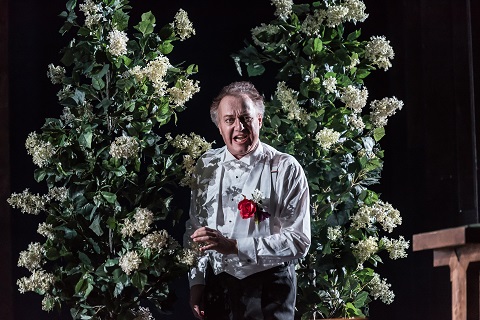 Johannes Martin Kränzle (Beckmesser). Photo credit: Clive Barda.
Johannes Martin Kränzle (Beckmesser). Photo credit: Clive Barda.
Johann Martin Kränzle was outstanding as Beckmesser, preening and prim, and oozing smug self-satisfaction. He pulled off the ‘singing badly well’ paradox, and acted superbly with his voice. After his final humiliation, he lurked in the shadows, his peacock robes replaced by a grubby white vest; a troubling figure of pathos.
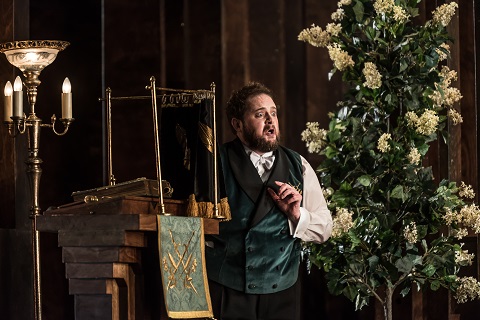 Allan Clayton (David). Photo credit: Clive Barda.
Allan Clayton (David). Photo credit: Clive Barda.
Allan Clayton was confident and exuberant as David; the role was exceptionally well characterised and Clayton was a persuasive presence, even when some of the business around him was not. He struck a good rapport with Hanna Hip’s bright-toned Magdalene. Stephen Milling as Veit Pogner and Sebastian Holeck as Fritz Kothner also stood out for the authoritativeness of their singing.
The ROH Chorus were in hearty voice and chorus master William Spaulding enjoyed his moment in the spotlight, conducting the chorale singers, in Act 1. Antonio Pappano drove the action swiftly on - Meistersinger can run to five hours, this performance was barely four and a half - and the ROH Orchestra got better and better. If the overture lacked the full quota of both gravity and gleam, then the Act 3 prelude was particularly beautiful - and may have seemed especially touching given the unalleviated high temperature of the playing preceding.
Holten saves his best trick until last. When the club members arrive for dinner in Act 1, the female guests are banished: they are clearly just arm candy. But, when Eva sees both Sachs and Walther acquiesce to the power of tradition, she’s having none of it. That said, surely Wagner’s message is that ‘true’ art depends as much on tradition as it does innovation.
Claire Seymour
Richard Wagner: Die Meistersinger von Nürnberg
Hans Sachs - Bryn Terfel, Sixtus Beckmesser - Johannes Martin Kränzle, Walther von Stolzing - Gwyn Hughes Jones, Eva - Rachel Willis-Sørensen, Veit Pogner - Stephen Milling, David - Allan Clayton, Magdalene - Hanna Hipp, Fritz Kothner - Sebastian Holecek, Kunz Vogelgesang - Andrew Tortise, Balthasar Zorn - Alasdair Elliott, Konrad Nachtigal - Gyula Nagy, Ulrich Eisslinger - Samuel Sakker, Augustin Moser - David Junghoon Kim, Hermann Ortel - John Cunningham, Hans Schwarz - Jeremy White, Hans Foltz - Brian Bannatyne-Scott, Nightwatchman -David Shipley, Apprentices (Jeanette Ager, Maria Brown, Maria Jones, Clare McCaldin, Simon Biazeck, Phillip Brown, Edmond Choo, Freddie De Tommaso, Andrew Friedhoff, James Geer, James Scarlett, David Woodward,
Director - Kasper Holten, Conductor - Antonio Pappano, Set designer - Mia Stensgaard, Costume designer - Anja Vang Kragh, Lighting designer - Jesper Kongshaug, Choreography and movement - Signe Fabricius, Fight director - Kate Waters, Orchestra and Chorus of the Royal Opera House.
Royal Opera House, Covent Garden, London; Saturday 11th March 2017.
image=http://www.operatoday.com/170227_1213_meistersinger%20BRYN%20TERFEL%20AS%20HANS%20SACHS%2C%20RACHEL%20WILLIS-SORENSEN%20AS%20EVA%20%28C%29%20ROH.%20PHOTO%20BY%20CLIVE%20BARDA.jpg image_description=Patience, English Touring Opera product=yes product_title= Die Meistersinger von Nürnberg , Royal Opera House product_by=A review by Claire Seymour product_id=Above: The Royal Opera companyPhoto credit: Clive Barda
March 13, 2017
AZ Musicfest Presents Mendelssohn's Italian Symphony and Leoncavallo's Pagliacci
Although the original story may have been French, the libretto as acted out in Scottsdale was as hot as the Calabrian sun.
Felix Mendelssohn visited Italy on a tour of the continent that lasted from 1829 to 1831 At that time he wrote, “This is Italy! ... and I am loving it.” Later, he wrote his sister Fanny saying, “The Italian symphony is making great progress. It will be the jolliest piece I have ever done, especially the last movement.”
Scored for 2 flutes, 2 oboes, 2 clarinets, 2 bassoons, 2 horns, 2 trumpets, timpani, and strings, Mendelssohn's Symphony No. 4, the Italian, has four movements. The opening A Major Allegro Vivace is light, airy and joyful, but it leads into a Bach-like D Minor second movement that reminded me that it was Mendelssohn who had done so much to revive interest in the music of Johan Sebastian Bach. Listening to Robert Moody and the Arizona Musicfest Orchestra play that second movement could bring tears to the coldest eyes. The following Con Moto Moderato is again in A Major but the final movement, marked Presto, is in A Minor and it gives the conductor license to drive his orchestra as fast as possible. With an excellent orchestra containing the first chairs of many other orchestras, Maestro Moody played it Prestissimo and it brought down the house.
Since the Musicfest Orchestra took up most of the stage area, there was only a narrow platform at the back for Stage Director Michael Scarola and his Pagliacci cast to use in staging the opera's action. Composer and librettist Ruggiero Leoncavallo said his story of raw sexuality was based on a case that his father, a judge, handled when the composer was a child. Although that is possible, French author Catulle Mendès thought it resembled his 1887 play La Femme de Tabarin. The French author sued Leoncavallo, only to drop the charges when he, himself, was sued for copying a Spanish play.
The dramatic strength that Scarola drew from his Pagliacci cast was absolutely amazing. He gave us a sizzling rendition of the libretto, pointing out every bit of foreshadowing built into the plot. Although the original story may have been French, the libretto as acted out in Scottsdale was as hot as the Calabrian sun. Although no costumer was credited, the cast wore clothing from the second half of the twentieth century.
Arizona Musicfest’s choristers were raucous townspeople with children who loved being part of the show. Conductor Robert Moody maintained tight control of his players and never let them drown out a singer while he moved the dramatic aspect of the work forward without a nanosecond’s pause. This performance was a thriller.
Gordon Hawkins was a voluminous voiced Tonio who sang the prologue from the middle of the audience. It worked well in that rotund church and he sang “Incominciate” on his way to the stage. Tonio is often played as a hunchback but here he was good-looking bully.
Canio, played by tenor Carl Tanner, was a suave circus owner whose hair trigger temper quickly turned to violence. He considered Nedda his property and he did not intend to share her with anyone. Singing with a huge enveloping voice, he told us the story of the unhappy clown with resonant dramatic tones that flowed like waves over the audience. Jonathan Blalock sang Beppe, Canio’s drinking partner, with easy lyric tenor tones.
Nedda knows she is tied to Canio for life even though she is unhappy as his wife. At the beginning of the opera she reclines on a trunk looking up at the sky and envying the freedom of the birds. Elisabeth Caballero allowed us to be part of Nedda’s dream world as the birds she loved flew into the ether. Her golden middle tones and opulent high notes bloomed above the audience as she sang her lyrical aria. She made listeners sympathize with Nedda but she did not let her her situation control her.
Smooth voiced baritone Alexy Lavrov played Nedda's lover, Silvio, a stable young man with a job in the town. The fact that he was not a member of the touring circus attracted Canio' wife, but she knew she and Silvio could never settle down safely in a town where Canio could find them. Her marriage vows would be not only her death sentence, but his as well. This was one of the most thrilling renditions of Pagliacci I have ever seen.
Maria Nockin
Cast and production information:
Robert Moody, Conductor; Carl Tanner, Canio; Elizabeth Caballero, Nedda; Gordon Hawkins, Tonio; Alexey Lavrov, Silvio; Jonathan Blalock, Beppe; Arizona Musicfest Chorus; Michael Lewis, Chorus Master; Members of Phoenix Children's Chorus; Michael Scarola, Stage Director.
image=http://www.operatoday.com/Pagliacci-5.png
image_description=Carl Tanner as Canio and Elisabeth Caballero as Nedda [Photo by Tim Trumble]
product=yes
product_title=AZ Musicfest Presents Mendelssohn's Italian Symphony and Leoncavallo's Pagliacci
product_by=A review by Maria Nockin
product_id=Above: Carl Tanner as Canio and Elisabeth Caballero as Nedda [Photo by Tim Trumble]
March 12, 2017
English Touring Opera Spring 2017: a lesson in Patience
Ever since an anonymous first-night critic in 1881 attempted to identify Gilbert’s ‘idyllic’ poet Archibald Grosvenor with Arthur Swinburne speculation has associated Grosvenor and his rival versifier, the ‘fleshly’ Reginald Bunthorne, with prominent aesthetes of the 1860s such as Edward Burne-Jones, Dante Gabriel Rossetti, James McNeill Whistler and of, course, the most glorious fop of them all, Oscar Wilde.
Interestingly, when impresario Richard D’Oyly Carte sent Wilde to the US on a lecture tour to illustrate the target of Patience’s satire, the resulting positive reception led to D’Oyly Carte’s wry observation that, ‘Inscrutable are the ways of the American public and absurd as it may appear, it seems that Oscar Wilde’s advent here has caused a regular craze and given the business a fillip up.’
But, today G&S is very much a matter of individual taste. And, then there’s the question of updating: if the creators were lampooning their contemporaries, should a present-day director turn the sardonic spotlight on modern mores and manners? While Jonathan Miller may have successfully excised Japan from the Mikado, there are many ‘modernisations’ which trip themselves up on the pedantry of ‘relevance’.
Director Liam Steel plays it straight in this ETO production, and the cast perform with the regimental conformity of good executants performing a work of genius. The knee-bends, handkerchief flourishes, fan-flapping, goose-stepping etc. are timed to perfection; but neat choreography does not a comedy make. There was a danger that the show would lapse into the clichés of pantomime or soap opera, and I longed for dramaturgy which sharpened the satirical edge and gave the performers greater freedom to ‘feel’ the dramatic moment. Perhaps such licence will blossom during the spring tour.
In 1882, Oscar Wilde visited Woodstock, Canada where he gave a lecture entitled ‘The House Beautiful’. Designer Florence de Maré’s set doesn’t quite call to mind the gilded stylisation of ‘ornamental aesthetic’ bravura, but she does give us the flora and fauna of a William Morris arts-and-crafts textile pattern - abundant in detail if lacking intensity of colour. De Maré’s muted green and pallid taupe may not conjure a synesthetic sensuousness fitting for a cult of beauty, but she does offer peacock feathers and vine-tracery aplenty. And, there is a match of visual motif and music, in the juxtaposition of the lethargic pallor of the languishing maidens’ ugly dresses and languorous refrain with the red-breasted dragoon’s robustness and readiness.
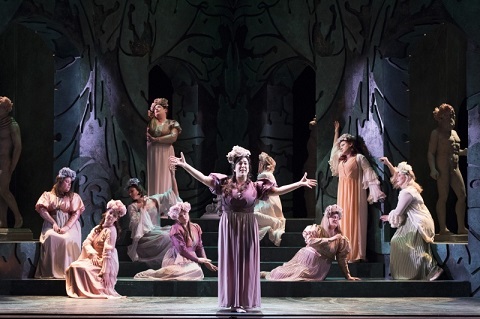 Melancholy, mediaeval Maidens. Photo credit: Richard Hubert Smith.
Melancholy, mediaeval Maidens. Photo credit: Richard Hubert Smith.
Patience is subtitled ‘Bunthorne’s Bride’ but in fact the eponymous ingénue dairymaid is not the leading character. Instead, the show is dominated by the rival poets Bunthorne himself and Archibald Grosvenor, who compete for the affections of the aforesaid maidens and Patience. Indeed, at the close, Bunthorne is singularly single, lacking a bride, despite the erstwhile attentions of the ‘love-sick’ maidens, who spurn their formerly affianced Dragoon Guards and their manly commander, Colonel Calverly, in his favour. When, by the end of Act 1, Bunthorne seems destined to wed Patience, one wonders if the musical entertainment is about to run into the ground; but, the arrival of the bookish Archibald Grosvenor re-directs the feminine gaze and the axe hovering over Act 2 is circumvented.
Arthur Sullivan’s score equals Gilbert’s text for playful parody and pointedness, and the ETO principals and chorus produced a charming performance that would make even the most G&S-phobic audience-member smile, if not guffaw. The young cast and the ETO chorus of ‘twenty [necessity resulting in the substitution, ‘several’] love-sick maidens’ and stiffly uniformed Dragoons proved well-versed in the idiom, both spoken and sung.
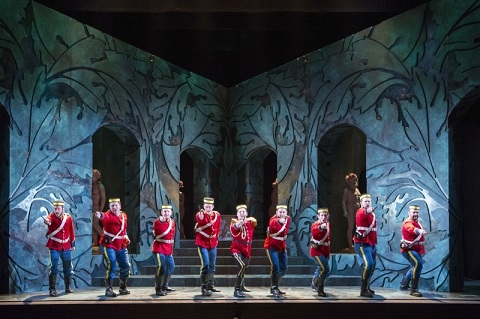 The Dragoon. Photo credit: Richard Hubert Smith.
The Dragoon. Photo credit: Richard Hubert Smith.
Though the overture lacked sprightliness, subsequently conductor Timothy Burke paced the drama effectively. Donizetti would have been proud of the Act 1 Finale.
Bradley Travis’s Bunthorne was an extravagant concoction of cerise and orange velvet, floral stockings lilies and peacock feathers, topped with an extravagant beret. Travis postured, posed and attitudinised with grace, gallantry and gentility, and stayed just the right side of camp droopiness. His ironically drowsy patter number, ‘Am I Alone and Unobserved, I Am’, got the show on the road, characterised by RP diction and effortless singing; and, Bunthorne’s ‘Oh Hollow! Hollow! Hollow!’ was delivered in a honeyed baritone not lacking a splattering of hypocrisy and humbug. The swift ‘If you’re anxious for to shine’ was deftly delivered. Travis has superb theatrical timing and knows when to turn up the comic thermometer: his ham-fisted attempts to fix the raffle to ensure that Patience is his bride almost came deliciously unstuck when Bunthorne wedged his elbow in the urn containing the ticket stubs.
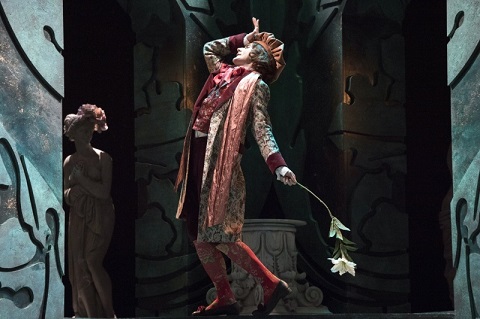 Bradley Travis (Bunthorne). Photo credit: Richard Hubert Smith.
Bradley Travis (Bunthorne). Photo credit: Richard Hubert Smith.
Ross Ramgobin evinced star quality as Archibald Grosvenor: Ramgobin’s beguiling baritone was powerful and clean, and gave substance to Grosvenor’s insipid amiability and mild-mannered, holier-than-thou-ness. Ramgobin’s Grosvenor was confident but sheered shy of smugness.
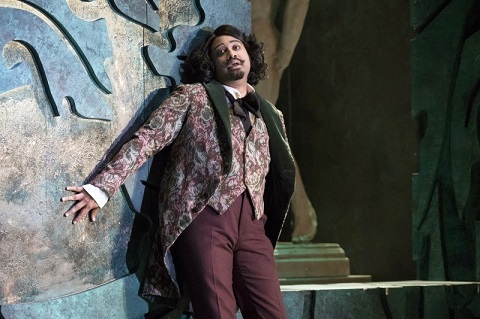 Ross Ramgobin (Archibald Grosvenor). Photo credit: Richard Hubert Smith.
Ross Ramgobin (Archibald Grosvenor). Photo credit: Richard Hubert Smith.
Lauren Zolezzi’s Patience sparkled with diamond-cut precision from her entrance aria, ‘I cannot tell what this love may be’. Her diction - indeed that of the entire cast - was so clear that, for once, surtitles might easily have been dispensed with. Zolezzi was a paragon of no-nonsense pragmatism; and she swung a laden milk-churn aloft with the same effortless ease with which she despatched the soprano’s lofty flights.
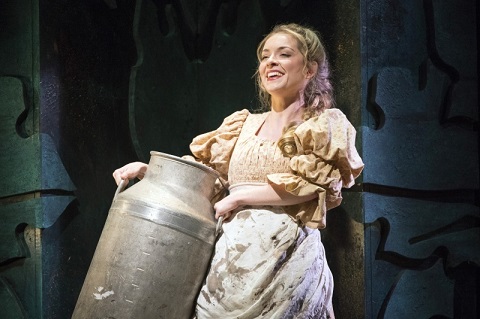 Lauren Zolezzi (Patience). Photo credit: Richard Hubert Smith.
Lauren Zolezzi (Patience). Photo credit: Richard Hubert Smith.
As Colonel Calverley, Andrew Slater was paradoxically blustering of spirit and nimble of voice in his patter number, ‘If you want a receipt’. Valerie Reid evoked sympathy for the pining Lady Jane, despite Gilbert’s unkind misogyny, in ‘Silver’d is the raven hair’, clutching her double bass trenchantly, and striking an adroit balance between gravity and comedy.
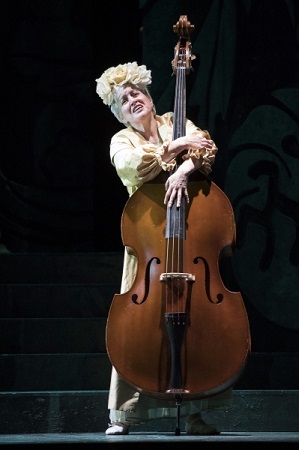 Valerie Reid (Lady Jane). Photo credit: Richard Hubert Smith.
Valerie Reid (Lady Jane). Photo credit: Richard Hubert Smith.
On the whole, Steel, too, struck the right balance between comedy and opera. In 1900, when a revival was being considered, Gilbert himself questioned whether Patience would appeal to then-contemporary tastes. His doubts proved unnecessary and Patience triumphed once more. And, why would it not? By the 1880s Aestheticism was no longer new: Gilbert was poking fun at more than while lilies and japanoiserie. His lampooning of those who starve life to feast on art speaks across the ages; one needs beauty and a square meal - and this production delivers both.
Claire Seymour
Gilbert and Sullivan: Patience
Patience - Lauren Zolezzi, Reginald Bunthorne - Bradley Travis, Archibald Grosvenor - Ross Ramgobin, The Lady Jane - Valerie Reid, The Lady Saphir - Suzanne Fischer, The Lady Angela - Gaynor Keeble, Colonel Calverley - Andrew Slater, Major Murgatroyd - Jan Capiński, Lieutenant The Duke of Dunstable - Aled Hall; Director - Liam Steel, Conductor - Timothy Burke, Designer - Florence de Maré, Lighting Designer - Mark Howland, ETO Ensemble and Orchestra.
Hackney Empire, London; Wednesday 8th March 2017.
image=http://www.operatoday.com/Bunthorne%20and%20Patience%20RHS.jpg image_description=Patience, English Touring Opera product=yes product_title=Patience, English Touring Opera product_by=A review by Claire Seymour product_id=Above: Lauren Zolezzi (Patience) and Bradley Travis (Reginald Bunthorne)Photo credit: Richard Hubert Smith
March 11, 2017
Tara Erraught: mezzo and clarinet in partnership at the Wigmore Hall
Once the slight, and forgivable, tension of the opening couple of items had been banished, Erraught revealed a full, gleaming mezzo which was bright at the top, honeyed in the middle and strong and characterful at the bottom. She moved easily between and across the registers, slipping silkily through coloratura passages, soaring warmly in more expansive episodes, and nailing every leap, twist, turn and flourish that was required of her.
In the concert arias with obliggato clarinet, however, she was matched, and on occasion outshone, by Pluta. A former principal clarinettist with the Staatskapelle Dresden and guest principal with many orchestras including the Bayerische Staatsope, Pluta’s innate musicality was winningly beguiling.
The use of obbligato - usually wind - instruments to complement and converse with the voice was a common practice in the oratorios and operas of the eighteenth century. In the nineteenth century, the obbligato instrument moved from the orchestra ranks and took its place in the concert aria and it was four of the latter that were presented here.
Louis Spohr’s Sechs Deutsche Lieder Op.103 were first performed in 1838; the solo part was written for the virtuoso instrumentalist Johann Simon Hermstedt, who asked Spohr to composer the work at the request of Princess Sondershausen. Piano and clarinet painted a bucolic mood-picture at the opening of ‘Zwiegesang’ (Duet song), conjuring the sweet scents and sounds of dusk: ‘In a lilac bush sat a little bird/ in the quiet, lovely May night.’ Erraught’s German diction was precise though her diligent attention to the text resulted at times in a lack of strong character-painting. However, the revelation that ‘Von Frühlingssonne da Vöglein saß/ Von Liebeswonne das Mägdelein’ (Of spring sunshine sang the little bird,/of love’s delight sang the young girl) was winsomely conspiratorial in tone, and her mezzo blossomed beautifully with the last line, ‘Vergeß ich nimmer mein Lebelang’ (I shall never forget my whole life long). The second Op.103 song, ‘Das heimliche Lied’ (The secret song), began with a clarinet flourish - a wincing spasm of pained lament which Baillieu transformed magically at the close into a gentle vision of hope and love.
Schubert’s Der Hirt auf dem Felsen played a large part in the elevation of the obbligato to the concert platform, but the composer’s disciples, including Franz Paul Lachner, were not slow to follow his example. The piano’s propulsive accompaniment at the opening of Lachner’s ‘Wach auf’ (Awaken!) were a rallying cry to live and act: ‘Was stehst du bange/ Und sinnest nach?’ (Why do you stand there/ brooding with fear?) sang Erraught, her dark lower register urgent and compelling. The second of two songs from Lacher’s Frauenliebe und Leben Op.82, ‘Seit ich ihn gesehen’ (Since I saw him), was similarly fervent; here, though, the rich and energised accompanying parts occasionally overwhelmed the vocal line when it fell to lower realms. The instrumentalists’ wonderfully modulated rallentando at the close was beautifully delicate.
Erraught seemed to shift up a gear in Schubert’s Der Hilt auf dem Felsen, relishing the operatic dimensions of this more substantial, and more accomplished, composition and its progression through intense emotions. She really engaged with the audience here, creating an absorbing characterisation. The tense drama of the instrumental introduction - the piano’s subtle rubato, the slightest of expressive delays on the first of the repeated chords, and a sleepy clarinet fermata - issued a challenge to the voice, to match the openness and smoothness of the clarinet’s opening melody, but Erraught equalled Pluta for mellifluous allure, evincing both power and clarity through the undulating phrases. The repeating triplets of Baillieu’s accompaniment were, as ever, judiciously weighed, and both instrumentalists were simultaneously dramatic and sensitive. The tempo of the minor-key central section of the aria, in which the shepherd reflects on his grief and loneliness, seemed quite deliberate and slow, but this only served to highlight the steady, icy flow of tears in the piano’s right hand and the quiet pain of Erraught’s gently decorated plaint, ‘Ich hier so einsam bin’ (I am so alone here). Soon, though, the exuberant final section, in which the protagonist celebrates the spring to come, chased away wintering melancholy.
In the four operatic numbers that comprised the second half of the programme, Erraught revealed the extent of her expressive range and a stalwart technique. She seemed more comfortable in this dramatic mode, more naturally accommodating her large mezzo to the intimate Wigmore Hall while hiding none of its power and palette.
Erraught captured all of Sifare’s pathos and hauteur in ‘Soffre il mio cor con pace’ (My heart endures calmly) from the adolescent Mozart’s opera seria, Mitridate, re di Ponto, nailing, in the opening phrase, the sustained note that expresses Sifare’s forbearance and the wide leaps that convey his inner agitation. With Mitridate away fighting a war against Pompey the Great, his two sons, Farnace and Sifare battle for the love of their father’s new bride, Aspasia. She, afraid of Farnace’s passionate advances, issues a despairing appeal to Sifare and he, after agreeing to protect her, exclaims in this aria that while he can withstand a woman’s beauty, a man’s pride cannot be abided - thereby offering Mozart two opposing emotions to comply with the conventions and structure of the da capo form.
Mozart’s vocal writing is demanding: the fifteen-year-old relied more on coloratura flamboyance than the emotional mood-painting of his mature operas to capture the wild ups and downs of love. Erraught was untroubled by the wide leaps, flourishes and extensive scalic runs that traverse the full range of the voice. The sudden transitions were convincing, and the lyricism of the slow, triple time ‘b’ section offered a quiet anguish to counter the statuesque indignation of the opening section.
Adolescent ardour and self-belief of a different kind were on display in Cherubino’s ‘Voi che sapete’ from Le nozze di Figaro, where the richness of the plummeting final phrases suggested the young page’s candidness and incipient maturity.
Erraught offered two rarely heard works by Rossini to close the programme. Rosina’s frequently cut ‘alternative’ aria, ‘Ah se è ver che in tal momento’ (Ah, if it is the truth), from Il barbiere di Siviglia -that Rossini composed for the soprano Josephine Fodor Mainvielle - was impressive for the delicacy of the coloratura, which leapt lightly and fully captured the vulnerable Rosina’s fears that Lindoro has betrayed her. The floating lyricism of ‘Ah se è ver’ was effectively balanced by the later bravura, as Rosina declares her faith in Lindoro’s innocence and rejoices in his ‘compassionate love’.
Erraught’s technical security was similarly impressive in the composer’s solo cantata Giovanna d’Arco (Joan of Arc). The first recitative, in which the protagonist reflects on the mission before him, is followed by an aria devoted to her mother. The second part interrupts such reflections with thoughts of war and the summons of an angel of death. Erraught conveyed Joan’s extraordinary emotional capacity, from the force of the protagonist’s patriotic fervour - ‘O patria! O re! Novella un’aita verrà’ (O my country! My king! A new source of help will come) - to the lilting grace of maternal adoration. She effectively controlled and shaped the growing intensity, culminating in the proud rhetoric and majesty pride in the second part of the cantata, which was heightened by Baillieu’s characterful accompaniment.
The Wigmore Hall audience was warmly appreciative, and Erraught was keen to encore. I felt, though, that Sesto’s ‘Parto, parto’ from La clemenza di Tito, Mozart’s final opera seria, might have been included as a conclusion to the ‘main programme’; a substantial work - and finely performed by Pluta and Erraught - it seemed to demand a ‘full billing’, and it would have neatly complemented the opening work. Two more short encores followed - Percy French’s ‘Long, long ago in the woods of Gornamona’ and Aaron Copland’s ‘Long time ago’ - which allowed us to appreciate the gentle sweetness of Erraught’s mezzo but which seemed unnecessary adjuncts to what was a rewarding, thoughtful and well-conceived programme.
Claire Seymour
Tara Erraught (mezzo-soprano), James Baillieu (piano), Ulrich Pluta (clarinet)
Louis Spohr: ‘Zwiegesang’ Op.103 No.2, ‘Das heimliche Lied’ Op.103 No.5, ‘Wach auf’ Op.103 No.6; Franz Paul Lachner: ‘Auf Flügeln des Gesanges’, ‘Seit ich ihn gesehen’ Op.82; Franz Schubert:Der Hirt auf dem Felsen D965; Mozart:Mitridate, re di Ponto K87 - ‘Soffre il mio cor con pace’, Le nozze di Figaro K492 - ‘Voi che sapete che cosa e amor’; Rossini: Il barbiere di Siviglia - ‘Ah s'e ver’, ‘Giovanna d’Arco’.
Wigmore Hall, London; Monday 6th March 2017.
image=http://www.operatoday.com/Tara%20Erraught.jpg image_description=Tara Erraught, James Baillieu and Ulrich Pluta at the Wigmore Hall product=yes product_title=Tara Erraught, James Baillieu and Ulrich Pluta at the Wigmore Hall product_by=A review by Claire Seymour product_id=Above: Tara ErraughtPhoto credit: Christian Kaufmann
March 8, 2017
Opera Across the Waves
The programme will feature contributions from Peter Gelb (General Manager of the Metropolitan Opera), Kasper Holten (outgoing Director of Opera at the Royal Opera House), Mark Schubin (Engineer-in-Charge at the Metropolitan Opera), Barrie Kosky (opera director), Stuart Skelton (tenor), Gundula Kreuzer (musicologist, Yale) and Ben Walton (musicologist, Cambridge).
Opera Across the Waves will air a matter of weeks before The Met celebrates the 50th anniversary of its move to the Lincoln Center. Opening its doors for the first time with the world premiere of Samuel Barber’s Antony and Cleopatra, starring Leontyne Price and Justino Díaz, The New York Times declared the opening of the new opera house a “crescendo of splendor” and a new era of theatrical possibility was born.
On 7 May 2017, the fully-staged Gala that celebrates the occasion will pay tribute to the company’s storied past and look ahead to the future, with some artists previewing roles they will perform in upcoming Met seasons. The Gala will include performances from many of the company’s most prominent singers including Piotr Beczała, Ben Bliss, Stephanie Blythe, Joseph Calleja, Javier Camarena, Dwayne Croft, Diana Damrau, David Daniels, Joyce DiDonato, Plácido Domingo, Yusif Eyvazov, Michael Fabiano, Renée Fleming, Juan Diego Flórez, Ferruccio Furlanetto, Elīna Garanča, Susan Graham, Vittorio Grigolo, Christopher Job, Mariusz Kwiecien, Isabel Leonard, Željko Lučić, Angela Meade, Latonia Moore, James Morris, Anna Netrebko, Kristine Opolais, Eric Owens, René Pape, Matthew Polenzani, Rolando Villazón, Michael Volle, Yunpeng Wang, Pretty Yende, Sonya Yoncheva and Dolora Zajick.
Berliner Philharmoniker’s Ruhr Residency (I): Camilla Tilling charms in the Childhood delights of Mahler’s Fourth
Pairing Ligeti with Mahler may seem odd at first, but they both shared the suffering of great family losses. Mahler mourned the deaths of several of his children, while the Hungarian Jew lost more than twenty family members during the Holocaust,. Those trauma’s resonate within the sorrows and horrors of their creative output. Where Mahler’s grandiose symphonies portray humanity and nature through beauty, Ligeti’s microtonal excursions seem attempts at unravelling the quantum fabric of the universe, as well as reflecting the capacity of horror in human beings.
For those lured by Mahler’s Symphony No. 4 in G major and unfamiliar with Ligeti’s extremes, his Violin Concerto must have been a nerve wracking confrontation. Though not immediately easy on the ears, Ligeti’s strangeness grows on you. Even with its extra-terrestrial tones, which the musicians bring to life through wild techniques, this concerto never alienates likes some of Ligeti’s other works.
A late work, Ligeti’s concerto is laced with hints of unexpected optimism. Through unsettling vibrations and microtonal subtleties, Ligeti’s journey alternates from dense to nearly transparent textures, culminating in an otherworldly musical realm. In search of nostalgia, acerbic passages pop out throughout the unsettling current, perhaps Ligeti’s wicked humor in his music helped with his coping. Rattle sustained a grounded focus; I never felt lost in Ligeti’s extremes.
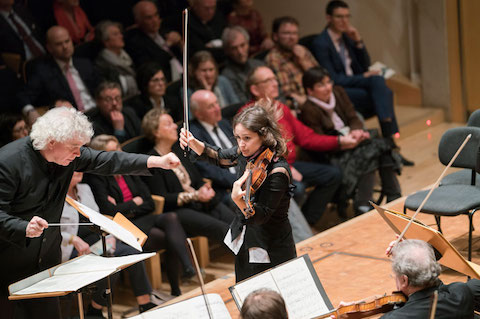 Patricia Kopatchinskaja in Ligeti's wildly dramatic Violin Concerto
Patricia Kopatchinskaja in Ligeti's wildly dramatic Violin Concerto
With the look of a poor fiddler, the French tomboy violinist performed barefooted in a shredded tuxedo that made her seem like a vagabond perhaps the most fitting for a Ligeti adventure. With dazzling virtuosity and a technical mastery, her raw theatricality played right into Mr. Rattle’s love for unconventional dramatic performances. The two had great chemistry. After she launched into the riveting cadenza, Sir Simon threw up his hands and left the stage, as if to say what do you still need me for? He returned later and conducted from the percussion section. Her Kurtag encore with the concertmaster was another delight.
In Mahler’s Fourth, Rattle’s supercharged intensity left me untouched till the final movement. He tackled it without score, and enforced Mahler’s frenzied tempos, while steadily slowing down in the quieter passages that often stirred in their romance. Skidding and slipping through the Viennese styles, Rattle’s fast-paced momentum reminded me of a highspeed merry-go round on the verge of spinning out of control. The complicated solo passages by the concertmaster were delivered with the illusion of perfect ease. Rattle fleshed out Mahler’s melodies with illuminating clarity.
Full of heart, Camilla Tilling sang “Das himmlische Leben” from Mahler’s Knaben Wunderhorn Songs. With resonance determined by a naive hope, she evoked the innocence Mahler intended. Towards the end her tone hinted at the threat of the end of childhood. She made a deep connection to the other musicians. In few instances, Mr Rattle’s volume drained out her voice.
After the adventurous thrills of Ligeti, Mahler’s Fourth felt more like an extravagant dessert than a main course. The symphonic ode to childhood innocence on the verge of being corrupted, had nothing on the horrors of Ligeti. The next day in Essen at Ligeti’s Le Grand Macabre, behind me two giddy ladies recounted their surprised joy of Ligeti: “Ah, aber das war sehr toll!”.
David Pinedo
Cast and production information:
Soprano: Camilla Tilling; Solo VIolinist: Patricia Kopatchinskaja; Berliner Philharmoniker; Conductor: Simon Rattle; February 24, 2017, Dortmund, Germany.
image=http://www.operatoday.com/maxresdefault.jpg
product=yes
product_title=Ruhr Residency with Mahler and Ligeti
product_by=A review by David Pinedo
product_id=Above: Camilla Tilling and Berlin Philharmoniker [All photos by Monika Ritterhaus]
March 7, 2017
Premiere: Riders of the Purple Sage
Bohmler’s one-time teacher, Carlisle Floyd, was present at the Phoenix opening. At the pre-performance lecture, Bohmler recalled some advice that Floyd had once given him, “If an audience has a vocabulary of 200 words, give them those 200 words plus 200 they don’t know.” With this opera he gave the audience what they knew and a great deal more in beautiful, original music.
Conductor Joseph Mechavich brought out Bohmler’s suave melodies and the distinctive motives that will hopefully become more familiar when we get to hear this well constructed music drama a second time. I, for one, hope the chance to hear it again happens very soon. Riders is a fascinating work that deserves to be heard often.
Kohn based his libretto on the Zane Grey novel of the same name and there is conflict in every scene of this work. When a woman inherits important land with herds of cattle and a spring on it, leaders of her church want to control it and her. However, she will not marry the husband they have chosen for her and she refuses to let them control her or her property. This opera even contains a major aria about a man's place in the American West and his perception of value of a gun.
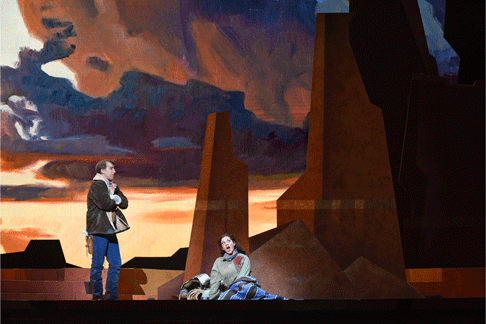 Amanda Opuszynski and Joshua Dennis as Bess and Bern Venters
Amanda Opuszynski and Joshua Dennis as Bess and Bern Venters
One of the lines on the supertitle screen described the white-hot intensity of the characters, “Maybe we all got scraped raw by the world.” The opera’s opposing views are as old as the Bible and as new as the latest Facebook page. Bohmler told AZ Central.com, “I wouldn’t have adapted Riders if I didn’t think that it spoke directly to what is going on today—which is religious fundamentalism, women’s rights, guns, and society.”
Stage Director Fenlon Lamb told the story in a realistic manner and the gorgeous skies behind Ed Mell’s distinctive, stylized sets blazed with an intensity that matched the heat of the drama. Kathleen Trott’s plain, functional costumes set the action in rural Utah at the beginning of the twentieth century.
Bohmler’s expansive score and its detailed orchestration called for dramatic voices and Arizona Opera answered with finely skilled artists who probably should be better known than they are at the moment. As Jane Withersteen, Karin Wolverton’s opulent voice flowed into the hall with golden radiance and she never seemed to tire, even though she had very little time off stage.
As her helper, the gunslinger Lassiter, Morgan Smith gave us a stunning performance of a role in which the character’s personality gradually unfolds and grows in complexity. These two artists played off each other and made exquisite music together. The younger couple, Joshua Dennis as Bern Venters and Amanda Opuszynski as Bess, sang with lighter, more lyrical voices that floated seamlessly above the audience.
As “bad guys” Elder Tull and Bishop Dyer, bass-baritone Kritopher Irmiter and baritone Keith Phares provided more than enough dark tones and evil opposition to contrast with the love of both couples. Hugo Vera was a capable Judkins and Henri Venanzi’s choristers provided small groups of harmonic townspeople. At the end of the evening the sound of the applause and the cheers for this important new work was deafening and it lasted for several minutes.
Maria Nockin
Cast and production information:
Conductor, Joseph Mechavich; Stage Director, Fenlon Lamb; Scenic Designer, Ed Mell; Costume Designer, Kathleen Trott; Lighting Designer, Gregory Allen Hirsch; Projection Designers, Jake Pinholster and Michael Batemen; Chorus Master, Henri Venanzi; Fight Director, Andrea Robertson; Jane Witherteen, Karin Wolverton; Lassiter, Morgan Smith; Bern Venters, Joshua Dennis; Bes, Amanda Opuszynski; Bishop Dyer, Kristopher Irmiter; Elder Tull, Keith Phares; Judkins, Hugo Vera; Co-producer, Kristin Atwell Ford.
image=http://www.operatoday.com/Riders-15.png image_description=Karin Wolverton and Morgan Smith as Jane Withersteen and Lassiter [Photo by Tim Trumble] product=yes product_title=Premiere: Riders of the Purple Sage product_by=A review by Maria Nockin product_id=Above: Karin Wolverton and Morgan Smith as Jane Withersteen and LassiterPhotos by Tim Trumble
March 5, 2017
English Touring Opera Spring 2017: a disappointing Tosca
Recent productions have inventively explored classical myth ( Xerses and La Calisto/Return of Ulysses ), offered Donizetti rarities ( Pia de'Tolomei and The Siege of Calais/The Wild Man of the West Indies ) and taken us to the moon ( Haydn ).
So, I arrived in expectant mood at the Hackney Empire for the first instalment of ETO’s slightly disconcerting pairing of Puccini’s ‘shabby little shocker’, Tosca, and G&S’s satirical romp, Patience (first night, Wednesday 8th May). The company’s website offers little illumination concerning the programming: ‘our two operas in Spring 2017 have absolutely nothing in common (except they are very, very good).’
Given that these ETO productions have to survive the trials of touring to multiple and diverse venues, the company cannot be chastised for embracing minimalism; but Florence de Maré’s designs are not simply functional, or even limiting, they are treacherous. A steep ramp and sharply raking steps are a singer’s potential graveyard. What is director Blanche McIntyre to do? Inevitably, there is a reluctance to commit, which translates from the physical to the emotional.
Moreover, there is little sense of the spiritual reality of the Church of Sant’Andrea della Valle: just a little trellised lattice-work, a judgmental statue of the Madonna, a trap-door (which later leads to Scarpia’s Room 101), and an easel whose representation we never see. With the cast too afraid to put one foot in front of the other, the overall effect is one of stasis. There is no sense of musico-dramatic unity; whatever is going on in the pit, the protagonists are standing/sitting still. There are bureaus and tables, and at times these offer dramatic possibilities - Tosca can pick up a knife from Scarpia’s desk - but also encourage the individuals to become entrenched in individual obsessions rather than to interact.
As Tosca, Paula Sides plays a huge part in redeeming this production; when she performed the role of Eleonora, Aurelia’s wife, in Donizetti’s The Siege of Calais I admired Sides’ ‘beautiful tone and shining vibrancy at the emotional climaxes’ remarking that ‘this was plush and thrilling singing’. This held true on this occasion: draped in Celtic green silk she was an embodiment of dignity and sincerity. Her ‘Vissi d’arte’ rightfully won applause; even if it felt more Handelian - in its statuesque nobility - than verismo.
And, individual roles do not lack stature: Matthew Stiff is an upright Sacristan, and Alexander James Edwards’ Cavaradossi is free of heart, though sometimes wayward of intonation.
Crucially, though, the villain of the piece is disappointingly muted. I praised Craig Smith’s performance as Eustachio in Donizetti’s Siege of Calais, enjoying his ‘Verdian intensity’, and stamina and accuracy - but the lovely smooth lower register I noted on that occasion seemed to have developed a few cracks and fissures. And, most importantly, there is simply no menace to Smith’s Scarpia; his knife-edge has been blunted.
The only singer who really makes his mark is Aled Hall as Spoletta, who in just a few seconds can register a supercilious contempt which chills the blood. As Tosca climbs the ladder of self-sacrifice, Spoletta follows her, and his ghastly grimace as the curtain falls contains all the hatred, anguish, fury and frustration that the production has failed to communicate.
Conductor Michael Rosewell whips through the business in unfussy fashion. But, I was not sure whether to describe this as a semi-staged performance. There was certainly little sense of unity of musical and physical movement. Perhaps G&S’s Patience will try the said forbearance less, and offer the requisite satirical bite.
Claire Seymour
Puccini: Tosca
Paula Sides - Floria Tosca, Alexander James Edwards - Mario Cavaradossi, Craig Smith - Baron Scarpia, Timothy Connor - Cesare Angelotti, Aled Hall - Spoletta, Matthew Stiff - Sacristan; Director - Blanche McIntyre, Conductor - Michael Rosewell, Designer - Florence de Maré, Lighting Designer - Mark Howland.
Hackney Empire, London; Saturday 4th March, 2017.
image=http://www.operatoday.com/2.1.ETO-Tosca-Tosca-Paula-Sides-CREDIT-Richard-Hubert-Smith-2.jpg image_description=Tosca, English Touring Opera product=yes product_title=Tosca, English Touring Opera product_by=A review by Claire Seymour product_id=Above: Tosca (Paula Sides) and Scarpia (Craig Smith)Photo credit: Richard Hubert Smith
A Winter's Tale: a world premiere at English National Opera
Wigglesworth tells the ‘tale’ clearly: swiftly and surely we follow the dismal progress that Leontes’ jealousy initiates. The composer-librettist has pruned and pared Shakespeare’s text, cherry-picking some of the play’s memorable and compelling one-liners - ‘Bitter on my tongue. Bitter in my thought.’ - but compressing and excising ruthlessly (one might feel, at times, mercilessly).
Indeed, the brevity of the opera - there is less than two hours of music - is both its strength and weakness. There is certainly an absorbing singularity of focus. But, Shakespeare’s play is more than one ‘tale’ and the erasures rob the drama of its structural parallels and linguistic richness. Yes, music can restore, represent and reinterpret much that has been removed, but Wigglesworth’s score, though beautiful, seemed on this single hearing to be more illustrative than dramatic.
This opera is not so much a ‘sad tale’ that’s ‘best for winter’, but a ‘serious’ Winter’s Tale. Comedy, romance and pastoral are all largely dispensed with, and so we are not offered the opportunity to revisit the ‘tale’ in different contexts and learn new meanings; this unbalances the structure of the drama, making the reversal and restoration of the final moments less convincing.
For when Shakespeare throws a foundling story into the mix he provides an escape route from the tragic trajectory which up until that point seems unavoidable. ‘Time, the Chorus’ ushers us into a new, natural world, one where Leontes’ mistakes need not be as important as they initially seem. And, though we return from the pastoral idyll in Shakespeare’s final act, the spirit of romance penetrates Sicilia. The ‘resurrection’ of Hermione harks back to myths of gods reborn as well as fairy-tales of ‘sleeping’ maidens. Leontes’ discovery of long-lost friend/daughter/son-brother, and the self-deceiving ‘lies’ that the lovers tell about their regal/non-regal status are the stuff of comedy. These generic echoes surely affect how ‘seriously’ we take Leontes’ jealousy and the statue scene?
Here, though, we have no Autolycus - that tale-teller and singer, rogue agent of Providence and man of masks who brings laughter into the tragedy. The all-singing, all-dancing confidence trickster is also an unwilling agent for good: he defects the Shepherd and Clown from taking the fardel to the King; and when he witnesses the denunciation of Florizel and Perdita by Polixenes, Autolycus decides, though his motives are ambiguous, to take a hand in the action, providing Florizel with his disguise.
Not only does Autolycus provide an antidote to sentiment in the pastoral comedy, he also offers a playful counterpoint to Leontes’ story, paralleling the latter’s self-destructiveness, acquiring a growing moral sense. At his last appearance on stage, Autolycus is declared true by the Clown who knows him to be false, a comic variation on Leontes’ declaration that he sees life in what he knows to be stone; both scenes form part of the pattern of discourses on the potential for regeneration in fancy and faith, and on the truth of art grounded in nature.
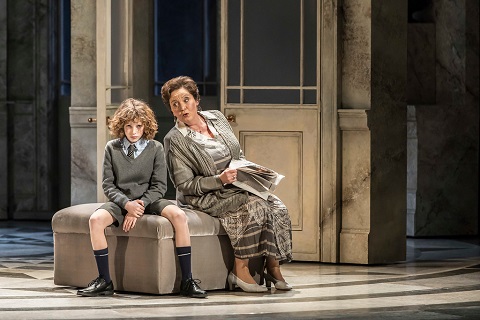 Zach Roberts and Susan Bickley. Photo credit: Johan Persson.
Zach Roberts and Susan Bickley. Photo credit: Johan Persson.
In Wigglesworth’s opera the latter theme, surely central to Shakespeare’s play, is outweighed - as is all else - by Leontes’ fanatical jealousy. In the brief second Act in rural Bohemia the debate that Polixenes has with Perdita about the relative merits of nature and art, so eloquently argued and which looks back to the stories of the opening and forwards to the reconciliation of the end, scarcely registers.
Of course, we are not watching Shakespeare’s play, and it is perhaps unfair to judge Wigglesworth opera on anything but its own merits. And, the latter are manifold. I began by noting the clarity and directness of the account and this is in no small part due to the nature of the text, and its setting: the short phrases are singer-friendly, full of open vowels and sympathetically set in a Brittenesque manner. (Indeed, there are more than a few spot-the-Britten-opera moments in the score, not least the reading of the indictment in the oracle scene which echoes Swallow’s interrogation of Peter Grimes.) The brevity of the text does mean that the rich figurative arguments of the language, its ‘poetry’, are lost - along with art and artifice, out go the diverse images of madness/imagination, flowers/fishing, sickness/medicine, lost/found, theatre, cosmology etc. - along with the patterning of particular words such as ‘hand’, ‘faith’, ‘fancy’. There is little difference between the register of the Sicilians and the Bohemians, though Wigglesworth uses the woodwind effectively in the rural act, distinguishing the sound-worlds.
The score is spacious and gentle, by turns lean - just a few instruments, or even orchestral silence - and then more luxurious. The instrumental palette is finely variegated; the Act 3 string intermezzo is tender and beautiful. But, the accompaniment does just that, accompanies; seldom does it create dramatic momentum. With the entry of the admirable ENO chorus - at the end of Act 1 as adulators of Hermione, and as festive Bohemians in Act 2 - there is an injection of impetus through the communal festivities that allow the significant mingling of the low and natural population with the court.
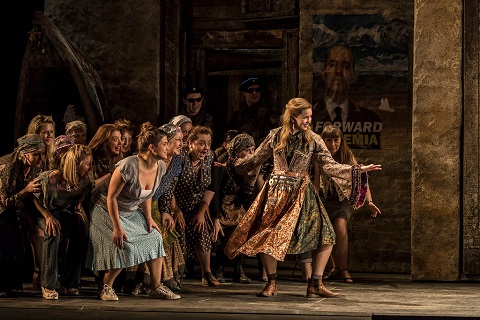 ENO Chorus and Samantha Price. Photo credit: Johan Persson.
ENO Chorus and Samantha Price. Photo credit: Johan Persson.
I was surprised, though, that the moment when Polixenes discovers his son’s plans to marry Perdita is elevated by Wigglesworth to a dramatic intensity equal to Leontes’ wrath in Act 1. There is an obvious parallel between Polixenes’ disapproval and Leontes’ unbending assertion that the world bow to his dream, but surely the pastoral convention - especially the interchange of royalty and shepherds - diminishes the potential impact of any ‘threat’? Then, having turned up the temperature of Polixenes’ ‘madness’, Wigglesworth resorts to unaccompanied spoken text for Polixenes, who bellows that Florizel is no longer his child/son/blood. Surely such a climax is deserving of musical representation?
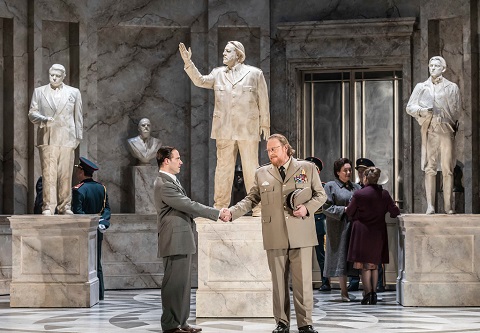 Leigh Melrose and Iain Paterson. Photo credit: Johan Persson.
Leigh Melrose and Iain Paterson. Photo credit: Johan Persson.
An enormous statue of the jealous tyrant dominates the Sicilian acts, and Iain Paterson was a towering vocal force, wonderfully embodying first the self-consuming grip of Leontes’ obsession and then the pathos of his ‘winter’, spent ‘in shame perpetual’. This performance was all the more impressive given the terseness of the text, for Paterson was deprived of Leontes’ spitting sequences of rhetoric questions and repetitions which have such an unstoppable momentum in the play, convincing him of the veracity of what in fact he knows to be false.
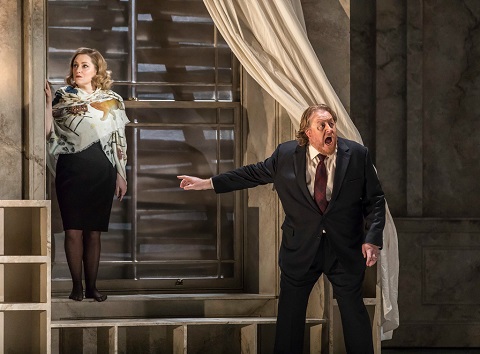 Sophie Bevan and Iain Paterson. Photo credit: Johan Persson.
Sophie Bevan and Iain Paterson. Photo credit: Johan Persson.
Sophie Bevan delivered some fine outbursts of injustice as the wronged Hermione: ‘There is a grief lodged here which burns’ literally scorches itself into the listener’s heart. Bevan’s soprano is big and rich, and she was well-served by Wigglesworth’s melodic writing. I found this Hermione a little too playful, however, when coaxing Polixenes to stay in Sicilia: charged by her husband to persuade his Bohemian friend to stay, she should be warm and companionable, but never in danger of losing her dignity.
Some literary critics have suggested that Hermione stands for divine Grace, or even the figure of Christ, but Bevan’s Hermione did not acquire such ‘grace’ until the final scene (and this seemed inconsistent with the earlier characterisation), when she offered Perdita a blessing. I wasn’t entirely convinced that Bevan really conveyed the tenacity of the mother’s desire to see her child grow and the strength of her belief in the oracle’s story which, when fulfilled redeem all - but the fault may lie with the adaptation and not with the singer.
Leigh Melrose was firm of voice and conviction as Polixenes, and both he and Timothy Robinson, as the trusted counsellor, Camillo, exhibited superbly clear diction. Robinson was a convincing ‘link’ between the rulers, his mannerisms suggestive of the characteristics of the two courts.
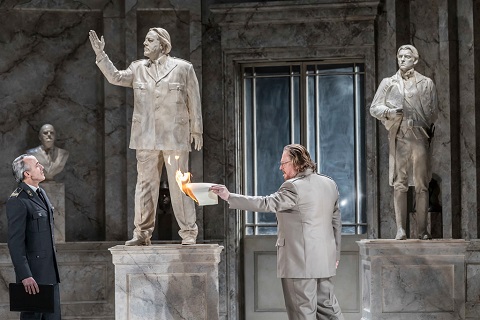 Timothy Robinson and Iain Paterson. Photo credit: Johan Persson.
Timothy Robinson and Iain Paterson. Photo credit: Johan Persson.
Susan Bickley’s Paulina was tough and confident, insistent on telling the king that Hermione is innocent and has delivered a baby girl. Loyal, frank and resourceful, Paulina’s willpower wins through, and Bickley remained ever-watchful fiercely reminding the old king of his dead wife and intimidating him during the stage-managing the denouement.
Audacious happiness radiated from Anthony Gregory and Samantha Price as Florizel and Perdita. This Perdita’s natural grace belied her lowly status and confirmed her royal strain, and Price’s lyric soprano was equally charming. Gregory used his lovely, warm tenor to raise Florizel above the stereo-type of ‘disguised lover-prince’, showing him to be both gallant and headstrong.
In an interview with The Guardian, Kinnear acknowledge the relevance of Shakespeare’s play in the context of current global politics: ‘It hasn’t escaped us that the piece is about regeneration. About how we still hold on to each other despite fractures, how good things can coalesce around those fractures. And yes, we’re doing a piece about an authoritarian, borderline-tyrannical leader who is appalling in his treatment of women, ignorant of nature, and quick to create borders between a neighbouring country. […] The timing of premiering it in February 2017 is slightly discomforting. Talk about opera being relevant.’
Wigglesworth and Kinnear leave us in no doubt about the potentially tragic consequences of humanity’s ineradicable wish to make the world fit our desires. We are pulled into Leontes’ narrow vision and we are repelled by the insanity of his perspective. As king, he can enforce his delusions on others, and it is only the conventions of pastoral and romance which prevent Leontes’ actions spinning into insanity and death. I just wish that this opera had more to say about art’s potential as a ‘healing power’.
Claire Seymour
Ryan Wigglesworth: The Winter’s Tale
Leontes - Iain Paterson, Hermione - Sophie Bevan, Perdita - Samantha Price, Polixenes - Leigh Melrose, Florizel/Court Official - Anthony Gregory, Paulina - Susan Bickley, Antigonus/Shepherd - Neal Davies, Camillo - Timothy Robinson, Mamillius - Zach Roberts, Two Guards - Geraint Hylton, Michael Burke, Servant - Paul Napier-Burrows; Rory Kinnear - director, Ryan Wiggleworth - conductor, Vicki Mortimer - set design, Moritz Junge - costume design, Jon Clark - lighting design, Imogen Knight - movement, Orchestra and Chorus of English National Opera.
English National Opera, London Coliseum; Friday rd March 2017
image=http://www.operatoday.com/ENO%20Chorus%20and%20Iain%20Paterson%20%28c%29%20Johan%20Persson.jpg image_description=The Winter’s Tale, English National Opera product=yes product_title=The Winter’s Tale, English National Opera product_by=A review by Claire Seymour product_id=Above: ENO Chorus and Iain PatersonPhoto credit: Johan Persson
March 2, 2017
Wexford Festival Opera announces details of 2017 Festival
66th Wexford Festival Opera 19 October - 5 November 2017
Full programme details and casting -
Wexfordopera.com
The 66th Festival will open with Medea by Luigi Cherubini directed by Fiona Shaw, who is known for both her award-winning theatre and film acting work, including playing Medea, in a production that originated at the Abbey Theatre before moving to the West End and eventually onto Broadway, earning her a Tony nomination. In recent times, she has been making a significant impact as an opera director with productions such as Riders to the Sea, Henze’s Elegy for Young Lovers and The Marriage of Figaro for English National Opera, The Rape of Lucretia for Glyndebourne and the Deutsche Oper, Berlin. Fiona Shaw will also deliver the 2017 Dr Tom Walsh Lecture on Saturday, 21 October in Clayton Whites Hotel.
The other two main evening operas include the highly anticipated Margherita by Jacopo Foroni, which hasn’t been seen or heard since it premiered in Milan in 1848 and Risurrezione by Franco Alfano, based on the Tolstoy novel.
The festival is also delighted to present a co-production with Opera Theatre Company, the world-premiere of two one-act operas entitled,Dubliners. Based on Counterparts and The Boarding House from Joyce’s Dubliners, the operas are composed by Andrew Synnott with adaptation and text by Arthur Riordan. Performed by a cast of six accompanied by piano and string quartet.
Commenting on the upcoming Festival, Artistic Director David Agler said, “ For the first time in many years five of the six operas produced are sung in Italian. The 66th Festival will open with Medea by Luigi Cherubini, an opera which had a sensational reception at its premiere in 1859, after which, like so many Wexford revivals, the opera went into decline. I am delighted that two distinguished Irish artists, director Fiona Shaw and designer Annemarie Woods, will make their Wexford debuts with this production. Leading the orchestra will be conductor Stephen Barlow. Several exceptional young singers will be involved in the production including the remarkable Norwegian Lise Davidsen, nominated Best Young Singer in the 2017 International Opera Awards and Russian tenor Sergey Romanovsky.
“Margherita by Jacopo Foroni will be the second opera by this only recently rediscovered composer to be presented in Wexford. The surprise hit of the 2013 Festival was Foroni’s Cristina, regina di Svezia which went on to win a major prize for Wexford at the International Opera Awards. Making their Wexford debuts will be director Michael Sturm and designer Stefan Rieckhoff. Our conductor will be Timothy Myers, who led the excellent performance of Samuel Barber’s Vanessa last season. The cast will include singers on their way to promising futures. Alessandra Volpe, an impressive Italian mezzo-soprano will take the title role and Andrew Stenson will sing the part of Ernesto.
The third production at our 2017 Festival will be Franco Alfano’s Risurrezione based on Leo Tolstoy’s novel Resurrection . The creative team for this exciting verismo opera is in the hands of Festival veterans Rosetta Cucchi, Tiziano Santi and Claudia Pernighotti. Fresh from our 2015 Festival production of Guglielmo Ratcliff , conductor Francesco Cilluffo will lead the Wexford Festival Orchestra and Chorus.
“And in another first for Wexford, we will present a co-production with Opera Theatre Company, the world-premiere of Dubliners by Irish composer Andrew Synnott as part of our daytime ShortWorks. In addition to customary lunchtime recitals, lectures and the Gala Concert throughout the extended 18-day Festival, I am delighted to announce a piano recital in the National Opera House with Ireland’s own outstanding pianist Finghin Collins, as well as the return of Una Hunt, Ireland’s leading authority on Irish composers whose music has been largely forgotten or neglected. Una has assembled a very special programme from the music of the much beloved Thomas Moore. ”
The main evening operas:
Medea
Based on the Euripides play, Medea is one of the most notorious figures from Greek mythology, a sorceress whose main claim to fame is the event that brings down the curtain on Cherubini's opera: She murders her own children in revenge for her husband, Jason’s, betrayal. Cherubini’s masterpiece remains a work of which everyone has heard, famously recorded by Maria Callas, but relatively few opera lovers have actually experienced in the theatre. Medea is a fierce work, and not simply because of its subject matter.
Margherita
Following the success of Cristina, regina di Svezia at Wexford in 2013, acclaimed by many as one of the most worthwhile rediscoveries in the festival’s long history, another of Jacopo Foroni’s operas, his first,Margherita, premiered one year earlier than Cristina in front of the ‘home’ audience in Milan. It was greeted with considerable enthusiasm at the time, though like his other work, fell into obscurity after his untimely death at age 32. It is widely believed that had he lived he would have been a worthy rival to Verdi.
This light-hearted opera tells the story of a rural young woman Margherita and her quest to marry her soldier-love Ernesto. This is the first staging of the opera since its premiere in Milan in 1848. As there is no official recording of the opera either, it promises to be one of the highly anticipated productions of the Festival. A co-production with Opera Omaha.
Risurrezione
Franco Alfano is remembered today less for his own operas than for his role in completing another composer’s work - Turandot, left unfinished at the time of Puccini’s death. Risurrezione, the opera that brought Alfano his first taste of fame, premiered in Turin in 1904. Based upon Tolstoy's novel of the same name, Risurrezione is set in Russia and deals with the maid Katiusha and her ill-fated affair with Prince Dimitri Nekludoff.
One hour prior to the performance of each of these three productions, Pre-opera Talks are held in the adjacent Jerome Hynes Theatre. These free, informal talks give the audience some insight to the opera and the composer and offer the audience an opportunity to ask questions. Talks are free. No advance booking required.
A taster menu of one-hour ShortWorks (daytime short operas):
In addition to the three main evening operas, there will be three daytime ShortWorks operas that audiences have come to cherish just as much as the main evening operas. Intimately staged and approximately one hour in length, the ShortWorks operas are presented in the nearby Clayton Whites Hotel (formerly Whites of Wexford) and offer audiences the opportunity to enjoy a one-act opera or a condensed version of a more familiar opera performed by cast members of the evening operas.
The ShortWorks productions:
La Scala di seta by Gioachino Rossini, one his lesser-known works, belongs firmly to his early Italian years, and indeed is a key work in his development, even if it is only more recently that its jewel-like qualities have come to be fully appreciated. A fast-moving comedy, its title translates as ‘The Silken Ladder’ - in this case, a stairway to the heaven of various nocturnal rendezvous.
Dubliners by Irish composer Andrew Synnott with adaptation and text by Arthur Riordan two one-act operas; Counterparts and The Boarding House from Joyce’s Dubliners will receive its world-premiere for four performances only. The opera is written for a cast of six accompanied by piano and string quartet. Dubliners is a co-production with Opera Theatre Company.
Rigoletto by Giuseppe Verdi, a condensed version of the original, was the first of his operas to have remained popular since its premiere in 1851. Containing some of opera’s most beloved arias including ‘la donne é mobile’, the tragic story revolves around the licentious Duke of Mantua, his hunch-backed court jester Rigoletto and Rigoletto's beautiful daughter Gilda. The opera's original title, La maledizione (The Curse), refers to the curse placed on both the Duke and Rigoletto by a courtier whose daughter had been seduced by the Duke with Rigoletto's encouragement. The curse comes to fruition when Gilda likewise falls in love with the Duke and eventually sacrifices her life to save him from the assassins hired by her father.
Also extremely popular with Festival audiences, the Lunchtime Recitals (approximately 50 minutes in length) form an integral part of the daytime programme. The Lunchtime Recitals offer a unique opportunity to hear the principal artists of the Festival perform their favourite repertoire in the intimate and informal setting of St Iberius Church in the centre of Wexford town. Unsurprisingly, the Lunchtime Recitals sell out very quickly. The artists and their performance dates will be announced prior to the Festival.
Una Hunt, Ireland’s leading authority on Irish composers whose music has been largely forgotten or neglected, who will present The Thomas Moore Songbook a programme of Moore’s Irish Melodies. Two performances will be presented in the atmospheric setting of St Iberius Church on Thursday, 20 and Saturday, 28 October.
A special daytime package for €65 includes a Lunchtime Recital or Thomas Moore Songbook concert, lunch and a ShortWorks opera. Timings allow audiences to travel easily to and from Wexford by car, bus or rail within a day. Seating is allocated for all of these performances.
One of Ireland's most successful pianists, Dubliner Finghin Collins will perform a piano recital in the O’Reilly Theatre in the National Opera House on bank holiday Monday, 30 October at 11 a.m. Having initially studied at the Royal Irish Academy of Music with John O'Connor and the Geneva Conservatoire with Dominique Merlet, Finghin went on to winning awards in Ireland and ultimately achieving great international success by taking first prize at the Clara Haskil International Piano Competition in Switzerland in 1999. Since then he has developed a flourishing international career that takes him all over Europe, the United States and the Far East.
This year the Festival will present two lectures. On Saturday, 21 October, the 2017 Dr Tom Walsh Lecture will be given by Cork native, Fiona Shaw, renowned actress and theatre and opera director, marking her Wexford Festival Opera directorial debut. In addition to her critically-acclaimed opera directing, Fiona is also widely known for her extensive and celebrated acting performances with the Royal Shakespeare Company and the National Theatre, twice winning the Olivier Award for Best Actress; for various roles including Electra in 1990, and for Machinal in 1994. She won the 1997 Drama Desk Award for Outstanding Solo Performance for The Waste Land. Her other stage work includes playing the title role in Medea, at the Abbey Theatre, West End and on Broadway (2001-02) resulting in a Tony Award nomination. She was awarded an Honorary CBE in 2001.
On Saturday, 28 October in the Jerome Hynes Theatre in the National Opera House, Canadian broadcaster and associate professor of musicology at the Faculty of Music of the University of Montreal, Sylvia L’Écuyer will present a talk entitled Operas of the Past, Mirrors of our Present, exploring the trends in updating operas into contemporary circumstances. Both lectures are just €10 each.
A Festival tradition, the Gala Concert is one of the highlights year on year, featuring a collection of favourite party pieces from members of the Festival Company. All performers generously donate their time and talent and all proceeds go toward supporting Wexford Festival Opera.
Affiliated with the Festival since the 50s, are the Wexford Festival Opera Historical Tours, programmed by long-time associate of Wexford Festival Opera, Nicky Furlong on behalf of Wexford Historical Society. Led by expert guides, these tours explore places of historical interest throughout County Wexford’s ancient east, some well-known; some lesser known. The tours leave the Talbot Hotel car park at 10.30 a.m. sharp and return to Wexford by 1 p.m., just in time for the Lunchtime Recitals. The tours are free and are open to all. Full details of these popular tours are announced each year in September. No booking necessary. For more information visit www.wexfordhistoricalsociety.com
The Fringe Festival : Wexford Town also hosts a vibrant Fringe Festival to coincide with the Opera Festival, which includes art exhibitions, drama and musical performances, and of course the legendary Singing and Swinging Pubs competition. The Fringe Festival is coordinated by the Wexford Chamber of Commerce. Full details: www.wexfordfringe.ie
Priority booking for Friends of Wexford Festival Opera opens on a staged basis from Saturday, 25 March. General booking opens on Saturday, 15 April. For more information on how to become a Friend of Wexford Festival Opera, and avail of priority booking plus many other benefits throughout the year, visit www.wexfordopera.com/friends
For more information on how to travel to Wexford, accommodation, and the most up to date casting and programme details or to download the Festival brochure, visit www.wexfordopera.com.
The 66th Wexford Festival Opera is supported by grants from the Arts Council, Fáilte Ireland, and Wexford County Council.
image=http://www.operatoday.com/Logo.jpg image_description= product=yes product_title= product_by= product_id=